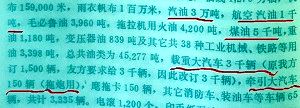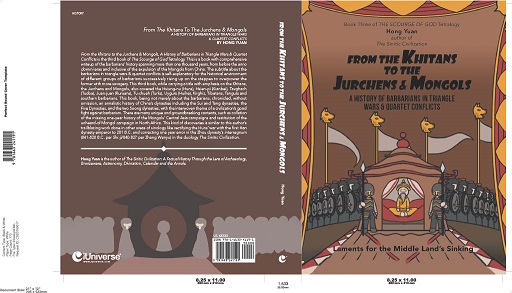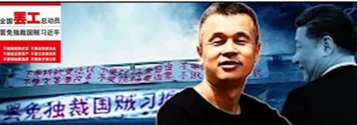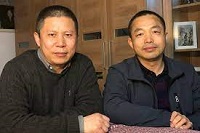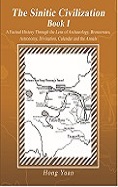
Sinitic Civilization-Book 1
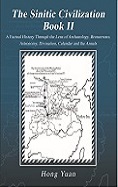
Sinitic Civilization-Book 2
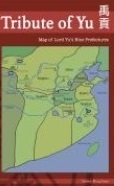
Tribute of Yu

Heavenly Questions
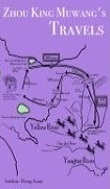
Zhou King Muwang's Travels
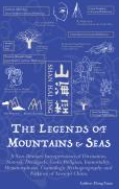
The Legends of Mountains & Seas
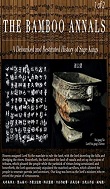
The Bamboo Annals - Book 1
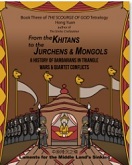
The Scourge-of-God-Tetralogy:
From the Khitans to the Jurchens & Mongols: A History of Barbarians in Triangle Wars and Quartet Conflicts
(available at iUniverse;
Google;
Amazon;
B&N)
|
|
TAIWAN
The first recorded official landing would probably be the expedition forces led by General Wei Wen and Zhuge Zhi in 230 A.D. At that time, Taiwan was named the 'Yi-zhou continent'. Wei Wen and Zhuge Zhi of the Wu Dynasty, during the Three Kingdom time period, with 10,000 armored soldiers, were in search of the 'Yi-zhou continent' [alien land] and the 'Tan-zhou continent' [probably Japan, i.e., the panacea island that Qin Emperor Shihuangdi's emissary Xu Fu was destined for]. Moreover, fleets of the Wu Dynasty, during the Three Kingdom period, had visited the faraway lands such as Champa [today's southern Vietnam and Cambodia] and today's Thailand.
The native Taiwan people were called 'shan-yi [mountain alien]' by Shen Ying of the Wu Dynasty, with description of rich soils, grain planting, weaving, winery, and weaponry using the dear horns, grinded stone arrowhead and stone hatchets. (Do note that 'shan-yi [mountain alien]' of the 3rd century may not be the same as today's Gaoshan-zu [high mountain minority] who were forced onto the mountains by waves of migration from outside of the island.
Across the Pacific Ocean islands, the stone adze, called 'duan-shi ben' in Chinese, were excavated, which showed a continental origin from the Southeast Chinese coastal area.)
* In Commemoration of China's Fall under the Alien Conquests in A.D. 1279,
A.D. 1644 & A.D. 1949 *
 U.S.S.R./Comintern Alliance with the KMT & CCP (1923-1927)
U.S.S.R./Comintern Alliance with the KMT & CCP (1923-1927)
 Korean/Chinese Communists & the 1931 Japanese Invasion of Manchuria Korean/Chinese Communists & the 1931 Japanese Invasion of Manchuria
American Involvement in China: Soviet Operation Snow, IPR Conspiracy, Dixie Mission, Stilwell
Incident, O.S.S. Scheme, Coalition Government Crap, Amerasia Case & The China White Paper
* Stay tuned for "Republican China 1911-1955: A Complete Untold History" *
|
|
Zou Rong's Revolutionary Army;
Shin Kyu Sik's
Shrine (Spirit, Kunitama) of Korea
|
This snippet is for sons and daughters of China:
Heed the sons & ministers' agony and sorrow of our ancestors who died or lived through the Mongol, Manchu and Soviet-Chicom conquest
and
the Yongjia, Jingkang and Jiashen cataclysms !
Jeanne d'Arc of China:
Teenager girl Xun Guan breaking out of the Wancheng city to borrow the relief troops in the late Western Jinn dynasty;
Liu-Shao-shi riding into the barbarian army to rescue her husband in the late Western Jinn dynasty;
teenager girl Shen Yunying breaking into Zhang Xianzhong's rebels on the horseback to avenge on father's death in the late Ming dynasty.
China's Solitary and Lone Heroes:
Nan Jiyun breaking out of the Suiyang siege and charging back into the city in the Tang dynasty;
Zhang Gui & Zhang Shun Brothers breaking through the Mongol siege of Xiangyang in the Southern Soong dynasty;
Liu Tiejun breaking through three communist field armies' siege of Kaifeng in the Republican China time period;
Zhang Jian's lone confrontation against the communist army during the June 3rd & 4th Massacre of 1989.
|
|
|
However, the early civilized ways of life in the 3rd century A.D. Taiwan, as described by Shen Ying, had apparently fallen out in the course of history in a similar fashion to the many lost civilizations such as Maya.
The Taiwan aboriginals were still commonly known as cannibals in the late 19th century: When the Taiwan aborigines killed the Ryukyu fishermen,
Japan mounted a short-term campaign in 1874 after the Manchus left an impression that it had no particular interest in suzerainty over the cannibals in Taiwan.
Even earlier, on March 12th of A.D. 1867, the 'headhunter' aboriginals killed a complete crew of Americans from Joseph Hunt and Mercy G. Beerman Hunt's shipwrecked Rover, that led to an American Asian Fleet's disastrous punitive military expedition conducted by Commander George E. Belknap and Lieutenant Commander Alexander Slidell MacKenzie against the Kaolut tribes.
Per Wang Zhonghan's citation of related research, at the time of Southern Soong Dynasty, the Jurchens had fled to the Penghu Islands (Pescadores) and Taiwan when the Mongols overtook northern China. Southern Soong Dynasty managed the Pescadores by subjecting the island to the Jinjiang county of the Quanzhou prefecture, and in 1171, built 200 houses for military farming projects on both Islands [the Pescadores and Taiwan].
Further, Wang Zhonghan cited Qing Dynasty's Zhu Jingying in stating that the Soong Dynasty currency/money, dating from the Taiping Era [976-984], Zhidao Era [995-997], Tianxi Era [1017-1021] and Yuanyou Era [1086-1094], had been excavated on the Taiwan Island.
Civilized seeds never survived in Taiwan.
Historical Confusion As To the Name & Location Of Taiwan
Confusion arose in the early historical records as to the name and location of Taiwan. While the Wu Dynasty, during the Three Kingdom time period, designated Taiwan as 'Yi-zhou', chronicles from the Sui Dynasty onward had possibly adopted a categorical term of "liu-qiu" [Ryukyu] for all islands in the seas, to the southeast of the Chinese coastline.
However, the skipping of Taiwan by Zheng Heh's Ming China fleets had given a clue that the Taiwan island was not a 'civilized' place as the rest of the world was. Also interesting would be sentences in Chinese chronicles [i.e., "Yuan Shi"] stating that "alien merchants [from Arab, Persia, India, Malacca and Thailand], who came to China to trade, did not mention Taiwan ..."
It was the Ming Chinese, who expelled the Dutch from Penghu Islands (Pescadores), who informed the Dutch of existence of the Taiwan Island.
Scholar Wang Zhonghan, like many other historians, stated that the ancient Chinese used "liu-qiu" [Ryukyu] for the designation of Taiwan. Prevalent websites from the "Taiwan nativity movements" or the "Taiwan independence movements" also identified with the ancient "liu-qiu" [Ryukyu] designation for Taiwan.
Confusion could possibly be rooted in ambivalence in "Yuan Shi", in which it pinpointed "liu-qiu" as opposite to Penghu [the Pescadores]. However, "Yuan Shi" was also self-admitting the fact that they did not know whether the March 29th, 1292 trip was actually destined for "liu-qiu" or not since the guide, i.e., Wu Zhidou, disappeared upon home-coming back in Penghu [the Fujian coastal port, not the Pescadores] on April 2nd for fearing the loss of three people killed by the aboriginals while attempting to land on a 25-kilometer-long island days earlier. (My intuition here is that in the Mongol times, both Taiwan and Penghu [the Pescadores] were grouped together as Penghu, as evidenced by the description of the strong currents in the Taiwan Straits that could blow away 99 out of 100 ships.
This was the historically know dark ocean gully that flew from the western Taiwan Island into the area between the Pescadores and Taiwan islands.
The Mongol ships purportedly passed through the San-yu-guo (three islands) country before sailing to 'liu-qiu' [Ryukyu], with San-yu taken to be Batanes of the Philippines.
Note that the Mongols, who attacked Java in A.D. 1293, exempted San-yu (Batanes) from sending in emissaries for its possession of 200 households, only.)
Having pointed out the categorical term of "liu-qiu", one could easily find some inconsistency in "Sui Shu" (History of the Sui Dynasty) to validate the point that "liu-qiu" [Ryukyu] was not necessarily Taiwan, but truly the real Ryukyu [i.e., what Japan called by Okinawa]:
Around A.D. 608, Sui Emperor dispatched Chen Leng and Zhang Zhenzhou to Ryukyu, and the two, departing from Yi'an, first sailed to Gaohua-yu Island, then after two more days, sailed to Xi-bie-yu [?] island in between, and then one more day later, reached Ryukyu.
The Japanese emissary, who accompanied Fei Qing [Fei Shiqing] back to China in A.D. 608, claimed that cloth and shields that Zhu Kuan had grabbed from "liu-qiu" [Ryukyu] were from the 'Yi-ye-jiu' statelet, which validated the close relationship between aboriginals along the archipelago.
Both "Sui Shu" and
Zhao Rushi's A.D. 1225 book "Zhu [various] Fan [foreign countries] Zhi [records]" mentioned that "liu-qiu" [Ryukyu] was 5-6 days trip to the east of Quanzhou of Fujian Province, while the Penghu Islands (Pescadores) and Taiwan are in fact situated to the exact southeast of Quanzhou.
It is clear to this webmaster that the Ryukyu Island referred in Sui records meant for Okinawa, while the two stopover island happened to be the Diaoyutai Islands, i.e., what the Japanese called by Senkaku Gunto [the Pinnacle Islands] after attacking and taking Taiwan in the context of the First Sino-Japanese War.
Beginning from Ming Dynasty, records about Taiwan began to show up in details, but with no trace of civilization.
"Ming Shi" lumped together about one dozen island countries or statelets, including Liu-qiu [Ryukyu], Luu-song [Luzon], He-mao-li, Mei-luo-ju [Malacca?], Sha-ya-na-bi-tan, Ji-long [Keelung, i.e., Taiwan], Puo-luo [Wenlai, i.e., Brunei], Ma-ye-weng, Gu-ma-la-lang, Feng-jia-shi-lan, and Wen-lang-ma-shen.
Here, the distinction was made between Liu-qiu [Ryukyu] and Ji-long [Keelung, i.e., Taiwan].
"Ming Shi" (History of the Ming Dynasty) stated that Zheng Heh, who conducted seven expeditions between 1405 and 1433, disliked Taiwan for its not catching up in submission of the tributes to the emperor as the rest of the world did. Zheng Heh should know that the Taiwan people, with no statelet or king, had no way to send in the tributes or have relations with mainland China.
"Ming Shi" recorded that Taiwan was called 'Ji (chicken) Long (hen-house) Shan (mountain)', a name which might have mutated into today's Jilong or the Keelung Port. There was a confusion in "Ming Shi" in regards to the position: Ji-long-shan was said to be to the northeast of the Penghu-yu Islands and hence it was also called 'Beigang' or the northern port. Alternative name would be 'Dongfan' or land of eastern barbarians. Because Taiwan islands' streams were not salty, it had another name called 'dan-shui-yang' or non-salty sea.
Taiwan's land was recorded to be 1000 Chinese li distance from Jilong in the north to Langqiao in the south, and 900 li distance from Duo-luo-man in the east to Wang-cheng in the west.
Another corroborating sentence in distinction of Liu-qiu [Ryukyu] and Ji-long [Keelung, i.e., Taiwan] would be Heh Kai's proposal to Ming Emperor Chongzhen in A.D. 1635: Heh Kai stated that "Taiwan, an island beyond Penghu Islands (Pescadores), could be reached after two days and nights of sailing if departing from Zhangzhou and Quanzhou of Fujian Province... To drive away red-haired devils as well as the bandits, sea ban must be enforced so that bandits could not make a living and the red-haired devils could not make a profit..."
Note that from Fuzhou port to Jilong, sailing would take 5 'geng', with 10 'geng' being equivalent to 24 hours.
The Ming government treated the Penghu Islands (the Pescadores) as its territories, but not Taiwan. It is said that the Mongol Yuan Dynasty had established a post on the Penghu Islands (Pescadores). Before that, by A.D. 1171, magistrate Wang[1] Dayou of the Quanzhou prefecture of southern Song Dynasty built 200 houses on the Pescadores for sake of military farming.
But in A.D. 1388, the Ming government abolished the garrison station.
It would be the Manchu invasion that triggered the mainland Chinese migration to Taiwan.
In the relatively recent documents of the Qing dynasty, there appeared the reference of Ryukyu Major and Ryukyu Minor, with the latter apparently referring to Taiwan as a result of reconciliation of errors in the history of prior dynasties.
Ilha Formosa
Christopher Columbus discovered the New World in A.D. 1492, Portuguese navigator Diaz reached the Cape of Good Hope in 1486, and Portuguese navigator, Vasco da Gama, opened the sea route between Europe and India by way of the Cape of Good Hope in A.D. 1497. This was the era of the great voyages and "great discoveries". However, the sea routes between Europe and India never needed to be re-discovered. The Arabians had sailed along the eastern coast of Africa for hundreds of years, and they had visited India, Malacca, Vietnam, and China all along. At the time of Han Emperor Huandi (reign A.D. 147-167), a series of emissaries from the west visited China via sea, arriving by sea from the south of Rinan Commandary (today's central Vietnam). Indian envoys were received at the Han Court in A.D. 159 and in A.D. 161, and an emissary from Daqin, i.e., the Roman Empire, arrived in A.D. 166. During China's Three Kingdoms time period, another Roman envoy arrived in Wu Dynasty, and when he left China, he requested with Sun Quan for a dozen pigmy people to be sent to Roman Emperor as a gift. (Sun Quan caught pigmy people somewhere south of the Huai River. The pigmy people, however, died en route to Rome.)
During A.D. 399-414, one Chinese monk, Fa Shien, had returned to China via the sea route, after spending years studying Buddhism in India. Tang Dynasty had recorded that East Roman emissaries had visited China via the sea route. Marco Polo certainly returned to Europe via the merchants' fleet.
When First Ming Emperor (Zhu Yuanzhuang) expelled the Mongols from Peking, there was an East Roman (Byzantium) emissary stranded in the Yuan Dynasty capital. Zhu Yuanzhuang made arrangement for the Roman emissary to return to Constantinople via a merchant fleet.
You could only say that human beings do not have good memories. The Hawaiians, 500 years before the Europeans came, had continuous voyages between the Islands of Hawaii and the various Polynesian islands. Suddenly, the Hawaiians lost the navigation skills and lived in total seclusion.
Portugal was the first European power to invade Asia. Vasco da Gama reached Calcutta in 1497. Portuguese established two castles in India in 1501 and 1502. In A.D. 1510, they captured Goa of India, and in A.D. 1511, they destroyed the kingdom of Malacca. The Sino-Portuguese War of 1521-1522 would see Portuguese driven off Guangdong's coast. From 1547 to 1549, Ming Governor Zhu Wan, also the imperial commissioner for coastal defence of Fujian and Zhejiang provinces, launched three attacks at the Portuguese, wiping out Portuguese stronghold at Shuangyu (Ningbo, Zhejiang), and killed and captured over 239 Portuguese at Wuyu (Zhuangzhou, Fujian) and Zoumaxi (Shaoan, Fujian).
The Portuguese, who were driven off from Zhejiang and Fujian coasts, later returned to the Guangdong coastline. In A.D. 1553, the Portuguese, claiming that their merchandise was wet due to a storm, requested with Deputy Coastal Magistrate Wang Bo for landing at Macao for sake of drying their goods. Once they landed, they refused to leave, and moreover built houses and castles. Yuan Jianbang and Yuan Guixiu, in their book "Brief History of Macao" (Zhongliu Publishing House, HK, 1988 edition) cited Huang Wenkuan's research that the Portuguese had bribed Wang Bo by means of a secret treaty, with clauses such as i) surrendering 1000 taels of silver to Wang Bo per year, and ii) changing the name to Portugal from Folangji [Falangji, i.e., the Franks], and etc.
The Ming Court did not check out the fake name of Portugal till A.D. 1565, by which time the Ming court once again declined Portugal's "tributes".
In A.D. 1517, a Portuguese fleet, on the way to Japan, sighted Taiwan and called it "Ilha Formosa", namely, the "beautiful island". However, 50 years before the Portuguese sailing, Ming China had dispatched seven royal expeditions across the South China Sea and the Indian Ocean. Ming China abruptly terminated the sea-faring adventures. Otherwise, they would have met the Portuguese on the seas.
* In Commemoration of China's Fall under the Alien Conquests in A.D. 1279,
A.D. 1644 & A.D. 1949 *
 U.S.S.R./Comintern Alliance with the KMT & CCP (1923-1927)
U.S.S.R./Comintern Alliance with the KMT & CCP (1923-1927)
 Korean/Chinese Communists & the 1931 Japanese Invasion of Manchuria Korean/Chinese Communists & the 1931 Japanese Invasion of Manchuria
American Involvement in China: Soviet Operation Snow, IPR Conspiracy, Dixie Mission, Stilwell
Incident, O.S.S. Scheme, Coalition Government Crap, Amerasia Case & The China White Paper
* Stay tuned for "Republican China 1911-1955: A Complete Untold History" *
|
|
Zou Rong's Revolutionary Army;
Shin Kyu Sik's
Shrine (Spirit, Kunitama) of Korea
|
This snippet is for sons and daughters of China:
Heed the sons & ministers' agony and sorrow of our ancestors who died or lived through the Mongol, Manchu and Soviet-Chicom conquest
and
the Yongjia, Jingkang and Jiashen cataclysms !
Jeanne d'Arc of China:
Teenager girl Xun Guan breaking out of the Wancheng city to borrow the relief troops in the late Western Jinn dynasty;
Liu-Shao-shi riding into the barbarian army to rescue her husband in the late Western Jinn dynasty;
teenager girl Shen Yunying breaking into Zhang Xianzhong's rebels on the horseback to avenge on father's death in the late Ming dynasty.
China's Solitary and Lone Heroes:
Nan Jiyun breaking out of the Suiyang siege and charging back into the city in the Tang dynasty;
Zhang Gui & Zhang Shun Brothers breaking through the Mongol siege of Xiangyang in the Southern Soong dynasty;
Liu Tiejun breaking through three communist field armies' siege of Kaifeng in the Republican China time period;
Zhang Jian's lone confrontation against the communist army during the June 3rd & 4th Massacre of 1989.
|
|
|
The Malayo-Polynesian Aborigines
The Malayo-Polynesian aborigines had dwelt on Taiwan for many thousands of years.
Prof Wei Chu-Hsien, in "China & America", had research into the 'bat cave' drawings on the Taiwan Island and concluded that the ancient Taiwan aboriginals had migrated there from coastal China about 5 to 6 thousand years ago.
http://mbe.oupjournals.org/cgi/content/abstract/20/2/214 carried an article about the new research paper by Society for Molecular Biology and Evolution, claiming that "The reanalysis of two previously published ancient mtDNA population data sets from Linzi (same province) then indicates that the ancient populations had features in common with the modern populations from south China rather than any specific affinity to the European mtDNA pool".
The people identified in this research paper had apparently pushed out the original coast dwellers who migrated across the seas to Taiwan and Southeast Asia.
The original coast dwellers created the Liangzhu culture [of the (O1a1-P203 Austronesian people] in the Taihu Lake basin about 5000-6000 years ago.
A high frequency of
O1 was found in the Liangzhu Culture sites around the mouth of the Yangtze River, linking this culture
to the modern Austronesian and Daic populations. This would be the O1a1-P203 group of people who
belonged to one of the four superclades of modern Chinese population. In Hemudu and Caoxieshan (straw
saddle mountain), carbonized rice kernels dated 5000 and 4000 B.C., respectively, had been discovered.
Liangzhu possessed the features
of a kingdom, with the sacrificial altars, the high-grade tombs, the large-scale
water conservancy facilities, and the unified religious emblems for the worship of gods.
This webmaster, in the prehistory section, had analyzed the ancient Chinese tribes to derive some conclusion that the bona fide coastal people was relative to the continental peers, and might not be bona fide at all as the coastal entrants, i.e., the O2-haplotype people could have evicted the O1-haplotype people towards Southeast Asia about 5000-6000 years ago while the two groups previously could have evicted the C-haplotype people to the seas (i.e., Melanesia), with the late-coming O1-haplotype people and the C-haplotype people mixing up to become the modern dual-genetic-origin Micronesians and Polynesians in the timeframe of about the last 800-3000 years ago, with the seafarer's arrival in Fiji timestamped 3000 YBP, Hawaii about A.D. 500, and Aotearoa A.D. 1200.
Professor Zhang Guangzhi (Kwang-chih Chang), having studied the remains on the islands, concluded that the seafarers arrived in Saipan about 1527 B.C., plus minus 200 years; the Easter Islands about A.D. 380, plus minus 100 years; and Hawaii about A.D. 1004 plus minus 80 years.
(In 78 B.C., there were some strange stone with tripods that appeared on the Shandong peninsula, and in the area of Mt. Taishan.
It was ascertained by the modern archaeology to be a so-called 'shi-peng' or the stone shed religious site that was observed to have spread from the Chinese coast to the Pacific Islands, something to do with the ancestors of the Pacific Islanders.
Across the Pacific Ocean islands, the stone adze, called 'duan-shi ben' in Chinese, were excavated, which showed the continental origin from the Southeast Chinese coastal area.)
The Taiwan aboriginals, who could have dwelled on the island 5000-6000 years, appeared to be relatively undeveloped versus the later waves of seafarers who might have taken the path of today's Vietnam, Malaysia and Indonesia to travel further to the Pacific Islands.
"Ming Shi" recorded that Taiwan had no king, but 15 'she' (societies or the tribal communities); that larger 'she' possessed over thousand people, and smaller 'she' 500 to 600 people; that the aboriginals had no clothing, men had piercings in their ears, women cut their side teeth for decorations, and they liked tattoos on hands and feet; that they liked to engage in village-to-village fights and kill other people; that they liked to hunt deers with sharp iron-arrowed bamboo spears; that Taiwan had no system of taxation; that the Taiwan people respected the bigger households with more kids; that the Taiwan people were afraid of seas and oceans and would rather die than sail to neighboring lands for exchanges; that they caught fish only in mountain streams and they disliked eating chicken or birds.
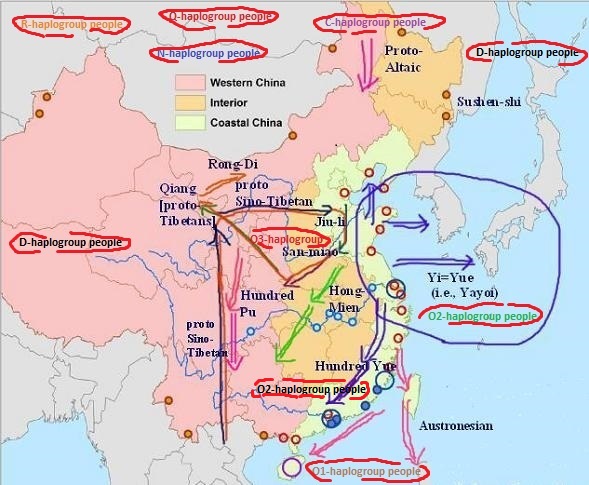
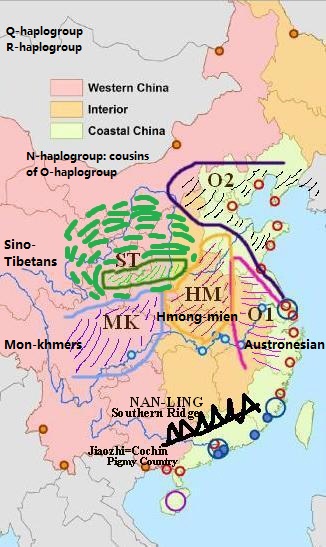
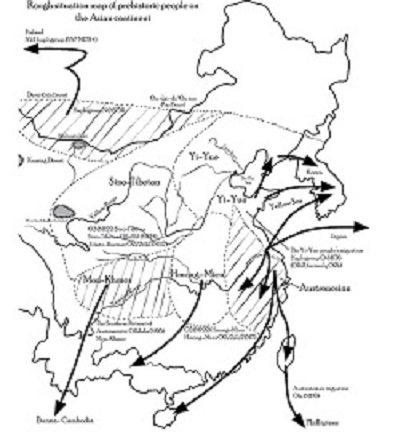
Ancient China's Island Policies
Two islands, Taiwan and Hainan, were not far away from China's coastline. Their fate was different. Hainan was colonized several times by Han China, but Taiwan was skipped in the early efforts. China was not interested in colonizing the island of malaria, Taiwan. Early China did possess navy to mount major campaigns, as evidenced by the naval operations along the coast of present-day Fujian during the third and second centuries B.C.E. Former Han, in its wars on Nan-Yue in 111 B.C., dispatched a fleet to Panyu, namely, today's Canton, at the mouth of the Zhujiang (Pearl River) Delta.
Sima Qian commented on Panyu as
a trading polis in Shi-ji, with products of pearls, rhinoceros horns, tortoise (hawksbill sea turtle)
shell bracelet/head plugs/rings, fruits and cloth.
When the Nan-yue remnants fled to the sea, the Han army pursued them to the Gulf of
Tonkin.
The fleet pursued the Nan-yue remnants to the Gulf of Tongking in Vietnam.
At the end of the second century B.C., after the conquest of Nan-Yue, Emperor Wudi set up two commandaries on the island, i.e., Dan'er ("drooping ears") and Zhuyai ("shore of pearls").
Emperor Wudi ordered to carve out the coastal land of Nanhai and Xiang-jun commandaries,
at today’s Leizhou peninsula, into the Hepu commandary.
At the Hepu port, close to one thousand Han dynasty tombs were excavated with gem stones
and glass products of the alien origin. It was apparent that the sea route trade carried the silk products to
Central Asia and ancient Europe, not the land route.
The next year, 110 B.C., Lu Bode took
over today’s Hainan Island that was made into the Zhuya (Zhuyai) and Dan’er commanderies. The Nan-yue
land, including central and northern parts of today’s Vietnam, was made into the commandaries of
Nanhai, Cangwu, Yu4lin [Guilin], Jiaozhi, Jiuzhen, Rinan, Zhuya and Dan’er, with Jiaozhi, Jiuzhen
and Rinan located inside today’s Vietnam. The Linyi (Champa) state would be where the Xianglin
County of the Rinan commandary was. Later, General Ma Yuan erected two bronze pillars here as
a demarcation line of Han China’s boundary. History recorded that the people living to the south of
Vietnam, in both Linyi (Champa) and Funan, possessed the curly hair, a Negroid characteristic that
had more to do with the Dravidians of India.
(At the end of Latter Han Dynasty, Sun Ce (brother of Sun Quan, the founder of Wu Dynasty of the Three Kingdoms) mounted an expedition, by sea from the Hangzhou Bay, to the mouth of the Min River in 196 A.D. Lü Dai of Wu Dynasty attacked the Shi family in Jiaozhi (today's Vietnam) by both land and sea in A.D. 226.)
Under Han China, the Hepu commandary was in charge of the shoreline between Guangzhou and Hanoi, including the Hainan strait and the Leizhou peninsula. Pearl fisheries were the incentive for Han to exercise control. The West River of today's Guangdong Province was utilized for trading and transportation. Hepu county had access by land to the West River in Yulin. As noted by http://www.anu.edu.au/asianstudies/south_china.html, "Hepu was the base for long-distance sea traffic, ... that officials of the emperor's private apartments were sent on missions as far as India to exchange the gold and silks of China for precious stones, curios and trinkets, while the pearls they brought back were as large as two inches diameter, far more valuable than those collected locally. The goods were assessed and traded in the market at Hepu, and then joined the local production of pearls for portage to the West River and then by the
rivers and canals to the north."
Frequent rebellion by locals caused Dan'er to be abolished in 82 B.C., and Zhuya (Zhuyai) in 46 B.C. At the beginning of Latter Han Dynasty, a county named Zhuya was re-established. Han Emperor Mingdi was said to have received tribute from Dan'er.
In the spring of 46 B.C., rebellion in the Shannan county of Zhuya (pearl cliff, i.e., Hainan Island) led
to the abandonment of the commandary, with the administrative agency incorporated into Hepujun
(Xuwen, i.e., today’s Zhanjiang, Guangdong). Earlier, in 82 B.C., the Dan’er commandary was
incorporated into Zhuya. This was a decision taken after the emperor listened to Jia Juanzhi, a great
grandson of Jia Yi. Jia Juanzhi claimed that the sage kings ruled the remote land with ‘sheng-jiao’
(i.e., the voice and creeds); that the Shang-Zhou dynasties did not extend their influence beyond ‘Mann-Jing’
to the south [and 'Jiang-Huang' {the Jiang-guo and Huang-guo states} to the east]; that the Great Wall’s song
was still being sung [about the skeletons of dead people building the wall for Qin Emperor Shihuangdi];
that Han Emperor Wendi declined and returned the remote land people’s surrender of the stallions; and
that the campaign against the Qiangs [in 61 B.C.] cost all the royal savings at the Da-si-nong ministry,
etc. Jia Juanzhi suggested abandoning the land of people with no caps and ribbons (i.e., ‘guan-dai’) for
retreating to the domain delineated in Yu Gong (Lord yu's tributes) and Chun-qiu (Confucius-abridged Spring & Autumn Annals).
During the 170s and 180s A.D., Han Emperor Lingdi of the Latter Han Dynasty sought for the establishment of the Gaoliang commandary over the east Leizhou peninsula. Attempts were made to establish posts on the Hainan Island.
http://www.anu.edu.au/asianstudies/south_china.html noted that "during the Han period, ... coastline of present-day Fujian... An outpost of the empire was maintained by the counties of Dongye and Houguan, at the mouth of the Min River by present-day Fuzhou... Something was known of Taiwan, then called simply Yizhou ... "Barbarian Island", but there was no official interest in the place. Further to the north, from the time of Han Emperor Shundi, the county of Yongning occupied the mouth of the Ou River by present-day Wenzhou in southern Zhejiang. None of the coastal settlements, however, appear to have exercised more than nominal control over their hinterland, and there was no drive to do so. The greater part of the mountain country of southeastern China, including all of Fujian, and great areas of eastern Guangdong,
southeastern Jiangxi and southern Zhejiang, was unoccupied land outside the
frontiers of the empire ..."
(During the early Han
dynasty, the Nan-yue (Southern Yue) state, which was the land conquered by a Qin expedition army
of 500,000, was belittled by Han emissary Lu Jia to be merely possessing a few hundred thousand
troops. The Eastern Yue state possessed even less people who were at one time forcefully resettled in
the Huai-shui River area. By the time of the Sui dynasty (A.D. 581-618), the former Min-yue and Dongyue
land possessed merely 12,420 households, with the demographics changing in the Tang dynasty
to reach 93,535 households at the time of Tang Emperor Xuanzong. From the genetic perspectives, the
Sino-Tibetans, carrying the O2a2b1 (M134) gene, were not related to the Yi-Yue people of Haplogroup
O-M176 (O1b2, formerly O2b) as they split like over 20,000 years ago. Though the two groups of people
apparently had the longest interaction among all groups of the Asian people, to the extent that the Yi-
Yue people’s original spoken language could now only be discerned from among the modern Koreans
and the Thai people.)
The Wo-kou Pirates & Taiwan
Ming China's records described the Taiwan island as a place dwelled by the barbarians and permeated with pestilence and other tropical diseases. It was also a place of hideouts for the pirates, outlaws and other bandits. History said that the Japanese pirates began to raid into China as a result of the unsuccessful Mongol invasion. The pirates, in collusion with Chinese outlaws, known as Wo-k'ou, had been plundering the Chinese coast for hundreds of years, and they used Taiwan as a base or hideout. When chased by the Ming forces, these pirates would flee to the Penghu Islands (the Pescadores), and then to Taiwan.
When 'Wo-kou' (Wa Japan pirates) raided the coasts of Fujian Province during late Jiajing Era (1522-1566), General Qi Jiguang was assigned the post of da jiangjun or grand general. Qi Jiguang drove off the pirates, and Wo-kou fled to seek refuge on the Taiwan Island. A follower of Wo-kou pirates, called Lin Daoqian, being unhappy over Wo-kou's control over him, sailed to a different place of Taiwan and cultivated the land into the Daoqian-gang Port. Taiwan aboriginals, under the pillaging by the Wo-kou pirates, vacated the beach lands for the high mountains. Later, Chinese merchant ships sailed to Taiwan and had exchanges with the aboriginals.
'Wo-kou' (the Wa Japan pirates) continued to raid China. In the autumn of 1584, a Japanese pirate, by the name of Duo-yan-chang-ang, led 3000 cavalry on an attack at Liujiakou, i.e., the Liuhe River rivermouth on the southern bank of the Yangtze. A Ming captain, Shen Yourong, led 29 brave soldiers against the pirates at night and defeated them. After that, Fujian governor (zhong cheng) ordered Shen Yourong, who was pian jiangjun (para-general) at Xiamen (Amoy), to campaign against the Japanese pirates on Taiwan. In early 1603, Shen Yourong led 21 ships against Taiwan. On the same snowy night, Shen lost 7 ships to typhoon near the Penghu Islands. But Shen managed to continue on his sailing. Upon arriving in Taiwan, Japanese pirates sailed their ships out of the port for a confrontation. Shen Yourong burnt 3 Japanese ships, retrieved 370 Chinese taken captives by the pirates, and drove the Japanese pirates off the Taiwan Island.
Further details about pirates could be seen at Japanese Piracy, Shogunate Tallies, Korea & Taiwan Island.
By the end of Wanli Era (1573-1620), 'hong (red) mao (hair) fan (barbarians)', i.e., the Dutch, reached the island, and the island came to be known as Formosa.
Taiwan & The Dutch
It would be in Ming Dynasty's history that we found description of modern Europeans, namely, 'cat-eyed', 'eagle-mouthed', and 'red-haired'. Interestingly, Ming Chinese did not talk too much about the Portuguese who were known as 'Folangji' (a word mutated from the Franks and could be linked to the cannons the Arabians manufactured on basis of the European design), while the Dutch was nicknamed 'Hongmaogui', namely, red-haired devils. In this sense, the Portuguese could appear much more different than the Dutch, and it made sense if the Portuguese sailors were mostly Italians who enjoyed relatively darker hair than northern Europeans.
In A.D. 1595, the Dutch, under command of Cornelius Houtman, arrived at Java.
In A.D. 1602, the Dutch ships appeared near the Chinese coasts and met resistance by the Portuguese. The Portuguese vilified the Dutch in front of the Chinese and hence the Dutch failed to get ashore.
In A.D. 1602, the Dutch, for competing with the Portuguese, formed the "Dutch East India Company", a company chartered for the monopolized trade as well as managing newly acquired colonies.
In A.D. 1603, the Dutch first attacked the Portuguese in Macau, but got repelled after sinking several Portuguese ships. The Dutch tried to wrestle Macao from the Portuguese, but were defeated again.
In A.D. 1604, the Dutch fleet, under Captain Van Warwijk, planned to attack Macau for a second time. Having encountered a hurricane, Van Warwijk led three ships to Penghu (the Pescadores) in August of the year. Penghu was abandoned by the Ming army already. The Dutch built a castle on the island. Van Warwijk dispatched an interpreter (Lin Yue) to Fujian Province, requesting for exchange of commerce, but Lin Yue was arrested by the Chinese. Further, Ming Dynasty dispatched Shen Yourong for quelling the Dutch disturbance.
Shen Yourong first ordered a ban of trade with the Dutch, making the Dutch difficult to advance or to retreat.
Shen Yourong led 20 ships and the Dutch interpreter (Lin Yue) to Penghu for expelling the Dutch.
Shen Yourong personally went to see Van Warwijk, explained the system of Ming China, rebuked Van Warwijk for his bribes of 30,000 gold nuggets, and stated that he had no authorization to commence trading with the Dutch. Shen Yourong released the interpreter and exchanged gifts with Van Warwijk. Shen Yourong also informed Van Warwijk that a Chinese traitor, Pan Xiu, who guided the Dutch to Penghu, would be penalized by execution. On Dec 15th of 1604, Van Warwijk left the Penghu Island.
In A.D. 1619, the Dutch took over Jakarta of Indonesia and named it "Batavia".
By the end of 1620, the Dutch intercepted ships between Macau and Malacca, acquiring information that the Spanish government intended to occupy a Taiwan port to counter the alliance of the Netherlands and Britain. The Dutch governor at Batavia, Jan Pierszoon Coen decided to attack Macau again and take over Penghu and Taiwan ahead of Spain.
On April 10th, 1024, the Dutch, under commander Cornelis Reyeresn, sailed in 8 ships to attack Macau. On June 24th, the Dutch arrived at Macau, bombarded Fort Saint Francois for five days, and landed 800 sailors ashore. But the Dutch were defeated, with a loss of 136 men in addition to 126 men wounded.
Withdrawing from Macau, on July 11th, 1622, the Dutch landed on the Penghu Islands which had altogether 100-200 people. Using a Chinese fisherman as a guide, Dutch commander Cornelis Reyeresn led two ships to seek Anping Harbor of Taiwan Island on July 26th for detecting the quality of the place as a port; they returned to Penghu on July 30th.
Anping Harbor of Taiwan had been frequented by the Japanese and Chinese merchant ships several times a year, with the Japanese buying deer skin from the aboriginals and the Chinese selling silk products to the Japanese.
The Dutch thought Anping Harbor was difficult to defend against outside attacks and decided to build a castle on Makung of the Penghu Islands on August 2nd. On Aug 7th, a Dutch, by the name of Van Meldert, led three ships to Fujian and asked a seaside official (shou bei) Wang Mengxiong relay a letter to Fujian Governor (hu tai) Shang Zhouzuo for exchange of commerce. On Sept 29th, Wang Mengxiong sailed to Penghu and gave Shang Zhouzuo's reply to the Dutch commander, asking the Dutch to vacate the Penghu Island and stating Ming China's refusal to trade with the Netherlands.
The Dutch built a fortress in Makung and harassed Portuguese vessels sailing in the Taiwan Straits. On the Penghu Island, the Dutch castle had a square side of 56.5 meters and it was equipped with over 20 cannons. The Dutch had about 10 warships around the island.
On February 23rd of 1623, Ming Chinese official stationed at Batavia proposed to the Dutch that Ming China would be willing to commence trading with the Netherlands should the Dutch vacate the Penghu Island (i.e., the Pescadores). Ming China softened its stance by informing the Dutch that they could retreat to Taiwan from the Pescadores.
From June 5th to June 13th of 1623, typhoon destroyed some walls of the fort. The Dutch raided the Fujian coast and abducted 1150 Chinese labor for rebuilding the fort. Among 1150 Chinese, 571 died of hard labor and bad nutrition, and another 486 later died of illness on board the ship for Batavia. "Ming Shi" recorded that the Dutch captured 600 Chinese fishing vessels during the time period; Penghu-xian County records stated that altogether 1300 people were abducted by the Dutch.
On July 23rd, 1623, Commandeur Christiaan Francx's relief fleet of one big ship and four small ships arrived at the Penghu Island. On Oct 28th, Christiaan Francx led 4 ships to Amoy for trade talk. On Nov 18th, Ming official tricked Christiaan Francx onto the shore and captured some of the Dutch. "Ming Shi" recorded that 60 Dutch, including Christiaan Francx, were decapitated. At night, shou bei Wang Mengxiong led 10 ships, which were disguised as fishing vessels, for a fire attack at two Dutch ships and burnt one ship. The second Dutch ship fled to the two other ships in the outer sea, and they left for the Penghu Island on Dec 7th.
The Ming government issued a decree in September 1623 banning all Dutch ships from approaching the southeast coast of China. In January 1624, Ming forces, under Fujian xun hu Nan Juyi, attacked the Dutch on the Penghu Island, and after eight months, the Dutch agreed to withdrawing from the Pescadores in exchange for retreat to the Taiwan Island.
Nan Juyi recruited soldiers from Quanzhou area and purchased ships. On February 20th of 1624 (Jan 2nd per lunar calendar), Nan Juyi ordered that Wang Mengxiong attacked the Dutch on the Pescadores. Wang Mengxiong intruded into Zhenhai-gang port of the Pescadores, and fought the Dutch and built the stone wall defence side by side, with casualties on both sides. Wang Mengxiong forced the Dutch into Fengkui-cheng castle.
Nan Juyi also ordered that du si or colonel Gu Sizhong led an army on an attack at the Penghu-zhen town on the Pescadores. From late May to early June, Nan Juyi personally sailed to the island and supervised two Ming circuit district governors in launching a third attack at the Dutch. On July 13th, Nan Juyi ordered that navy general Sun Guozhen led Liu Yinglong and Hong Jiyuan for an attack at the Dutch fleet somewhere near the Chinese sea goddess monastery.
On July 29th, Nan Juyi landed on the island and arranged for both land and sea offensives. On the island, the Ming army cut off the water supply to the Dutch. On August 3rd of 1624, the Dutch commander Marten Sonk arrived at the island with relief. 850 Dutch soldiers were retrieved from Taiwan. Meanwhile, Ming army swelled to 10,000 and 200 ships from original force of 4000 men and 150 ships.
The Dutch dispatched a negotiator for peace talk with zong bing Yu Zigao (son of Yu Dayou). The Dutch was informed that Ming China intended to evict the Dutch from the Pescadores only and that the Dutch could go to Taiwan at will.
On August 18th, Ming armies launched a three-prong attack. On Aug 24th, the Dutch raised the white flag to show surrender. Beginning from Aug 26th, the Dutch began to dismantle the castle in accordance with Ming China's demands and finished demolition by Sept 10th. Thereafter, the Dutch sailed to Taiwan.
Ming China's war with the Dutch was extraordinary in that Ming Chinese exerted great sacrifice in fighting a rising European power of unprecedented fire power. Nan Juyi stated in his report that the Dutch ships were extremely big and could bombard the small Chinese ships to powder and pieces over 10 li distance.
Li Ao, a critic of the KMT government on Taiwan, echoed Li Hongzhang's comments that Manchu China's confrontation with red-hair devils (i.e., British) was an extraordinary event not foreseen by China for 3000 years and that Britain, with its military might and fire-power, was an enemy China could not match during the course of past 1000 years.
Wrong ! The cousins of "red-hair devils", i.e., the Dutch, had arrived at Java in 1595 and the Chinese coast in A.D. 1602. From A.D. 1603 to 1624, Ming China exerted hundreds of ships and thousands of soldiers to repelling the Dutch from Chinese coasts and the Pescadores Islands. Often, numerous small Ming ships encircled few big Dutch warships for sake of winning the fight. Ming China mobilized a huge field army for landing on the Penghu Islands (i.e., the Pescadores) and after fierce fighting, forced the Dutch into withdrawal. Dozens of years later, Zheng Chenggong, son of pirate-turned Ming General Zheng Zhilong, would first adopt the approach of "defeating the aliens by means of aliens' weapons". Zheng Chenggong, whose merchant fleets had sailed to the four corners of the seas, actively purchased weapons, firearms and cannons from the Dutch. In February 1662, Zheng Chenggong successfully expelled from Taiwan the Dutch who, having colonized the island from 1624 to 1662, had latinized the aboriginals' language to the extent that the aboriginals no longer remembered their own native language.
In the ensuing hundreds of years, Manchu Qing China had been mostly occupied with "pleasure-seeking and literature-decoration", a 1916 comment by Japanese Prime Minister in regards to Yuan Shi-kai's death and its influence on the rise and fall of the Republic Of China. (The worst thing is that today's decadent Communist China is not any better
than the Manchu rulers. Red alerts !!)
In A.D. 1635, a Ming Dynasty minister, Heh Kai, submitted to Emperor Chongzhen a tactic for quelling the sea upheavals. Heh Kai mentioned the turmoil of Yuan Jin, Li Zhong, Yang Lu, Yang Ce, Zheng Zhilong, Li Kuiqi, Zhong Bin and Liu Xiang and recommended the destruction of the piracy base in Taiwan. Heh Kai stated that Taiwan, beyond the Penghu Islands, could be reached within two days by sea, departing from Zhuangzhou and Quanzhou ports; that coastal people went to Taiwan for taking advantage of the benefits of fishing and salts; that some people, taking advantage of Ming's lack of military influence, had gathered there to be rebels and bandits; that the Dutch, now having built castles on the island, had colluded with the non-obedient Chinese and made Taiwan into a big tribal country. Heh Kai proposed a 'sea ban' (blocakde of the coastal areas) to cause the Dutch nowhere to trade or profit and the non-obedient Chinese nowhere to make a living, and a campaign against the Dutch after successes from the blockade of the coastal areas.
The Piracy Along the Chinese Coasts
Japanese Piracy & Shogunate Tallies
Zheng Chenggong's Recovery Of Taiwan
The Ceding of Taiwan to Japan
After China lost the First Sino-Japanese War, on Dec 23rd [sc], 1894, John Watson Foster received the Manchu invitation for acting as China's mediator in talks with Japan.
John Watson Foster met Japan's minister-envoy to the U.S. before departing for Japan, and met with the Japanese foreign minister before meteing with the Chinese delegates.
On January 30th, at Kobe, John Watson Foster told Zhang Yinheng and Shao Youlian that their Manchu certification did not conform with the international diplomatic protocol.
On February 1st, Zhang Yinheng and Shao Youlian were dispatched to Yokohama for peace talk, but Ito later sent them to Nagasaki, claiming that the two officials did not have full authorization from the Manchu Qing Dynasty.
Ito inquired with Wu Tingfang as to reasons why Manchu King Gongqingwang or Li Hongzhang did not come to Japan.
John Watson Foster accompanied the Chinese delegates back to China.
Emperor Guangxu issued the decree on March 4th in making Li Hongzhang a plenipotentiary. Li Hongzhang left for Japan on March 13th on a German ship, with former U.S. secretary of state John Watson Foster on board as a counsellor, and arrived in Shimonoseki on March 19th.
On March 21st, Li Hongzhang declined Japan's demands to have their troops station at the Shanhaiguan Pass, Tianjin and the Dagukou Battery, while Ito secretly dispatched the Japanese troops against the Taiwan Island.
Three days later, at about 4:00 pm on March 24th, 73-year-old Li Hongzhang was shot in the face by a Japanese assassin. Li Hongzhang, with bullet still in the bone under the eye, refused to see doctor for sake of wrapping up the peace talk.
* In Commemoration of China's Fall under the Alien Conquests in A.D. 1279,
A.D. 1644 & A.D. 1949 *
 U.S.S.R./Comintern Alliance with the KMT & CCP (1923-1927)
U.S.S.R./Comintern Alliance with the KMT & CCP (1923-1927)
 Korean/Chinese Communists & the 1931 Japanese Invasion of Manchuria Korean/Chinese Communists & the 1931 Japanese Invasion of Manchuria
American Involvement in China: Soviet Operation Snow, IPR Conspiracy, Dixie Mission, Stilwell
Incident, O.S.S. Scheme, Coalition Government Crap, Amerasia Case & The China White Paper
* Stay tuned for "Republican China 1911-1955: A Complete Untold History" *
|
|
Zou Rong's Revolutionary Army;
Shin Kyu Sik's
Shrine (Spirit, Kunitama) of Korea
|
This snippet is for sons and daughters of China:
Heed the sons & ministers' agony and sorrow of our ancestors who died or lived through the Mongol, Manchu and Soviet-Chicom conquest
and
the Yongjia, Jingkang and Jiashen cataclysms !
Jeanne d'Arc of China:
Teenager girl Xun Guan breaking out of the Wancheng city to borrow the relief troops in the late Western Jinn dynasty;
Liu-Shao-shi riding into the barbarian army to rescue her husband in the late Western Jinn dynasty;
teenager girl Shen Yunying breaking into Zhang Xianzhong's rebels on the horseback to avenge on father's death in the late Ming dynasty.
China's Solitary and Lone Heroes:
Nan Jiyun breaking out of the Suiyang siege and charging back into the city in the Tang dynasty;
Zhang Gui & Zhang Shun Brothers breaking through the Mongol siege of Xiangyang in the Southern Soong dynasty;
Liu Tiejun breaking through three communist field armies' siege of Kaifeng in the Republican China time period;
Zhang Jian's lone confrontation against the communist army during the June 3rd & 4th Massacre of 1989.
|
|
|
The Japanese side, having previously procrastinated the talk for sake of making further military gains in China and Taiwan, finally agreed to the peace after the Li Hongzhang assassination by pretending a truce of 21 days.
On March 28th [sl], Ito paid respect for Li Hongzhang and relayed a message that the Japanese emperor had agreed to a ceasefire. The ceasefire agreement was signed on March 30th.
On April 1st, Japan proposed ten clauses which Li Hongzhang told Foster he could not accept.
Foster took charge in negotiating with Japan for some minor concession and pressured Li Hongzhang into accepting them.
On lunar calendar March 23rd (April 17th of 1895 per solar calendar), after eight months of war, the Treaty of Shimonoseki was signed between China (Li Hongzhang and Li Jingfang) and Japan (Ito Hirobumi and Mutse Munemitsu), with terms as follow: i) Full independence for Korea; ii) Cession of Liaodong Peninsula, Taiwan (Formosa), and Penghu Islands (the Pescadores); iii) 200,000,000 taels of silver (£25 million ?); iv) opening-up of the cities like Shashi, Chongqing, Suzhou, and Hangzhou as the trading ports and allowing Japan to establish consulates and factories in these ports; and v) extending to Japan special privileges that other Western countries enjoyed.
On April 24th, Foster volunteered to take the treaty to Peking for the Manchu emperor's ratification when Li Hongzhang dared not do so.
Foster mobilized the Western embassies and legations in Peking in claiming to the Manchu foreign affairs office that the Treaty of Shimonoseki was the best deal ever.
On May 8th, the Manchu court finally gave in.
On May 30th, Foster accompanied Li Jingfang to Taiwan for transferring Taiwan. When Li Jingfang was afraid of landing on Taiwan, Foster claimed that the Western diplomatic protocol would allow transfer to be legalized with a signed affidavit rather than to be validated by a de facto personal ceremony on the Taiwan Island.
On June 2nd, the transfer agreement was signed aboard a warship instead, with John Foster acting as the ultimate "facilitator" from beginning to end.
America, the stars that engendered or heralded the rise of the [Japan] sun, long ago had the blueprint to make Japan into a stalwart against China and Russia, i.e., the source of the Yellow Peril and the source of the Half-Tartars [or the Russians] --whom the Americans could not assimilate according to George Kennan.
The unfortunate thing is that America, i.e., the United States, was and is still shortsighted today, not knowing that Korea, at one time paradise of the American Evangelicals, was delivered into the hands of the Japanese imperialists as a result of the Anglo-American confrontation against Czar Russia, and in this geopolitical process, China, the land of the Great Sinitic Civilization, was made into a piggy-backed sacrificial/funereal object -the land ruled by the most evil cult called 'communism' that was an 'import' or an 'export' of Soviet Russia. America would not learn the lesson that the geopolitical actions it is taking today would yield the 'bad fruit' 50 years or 100 years down the road. (America, and their British cousins, must have forgot the twenty-year Anglo-Japanese military alliance that allowed Japan to develop the warplanes and aircraft carriers to invade mainland China, not to mention the post-WWI ten-year arms embargo against Republic China and George Marshall's post-WWII arms embargo against Republic China 1946-1948.
They forgot that in 1931, President Herbert Hoover gave Japan a free hand in the invasion of Manchuria on the pretext that Japan could not tolerate a half-Bolshevik China.
They of course forgot that
after the eruption of the 1937 Sino-Japanese War, the Anglo-Americans, biased towards Japan and against China, adopted a policy of "neutrality" (what Utley called by "unpositive neutrality") against the 'belligerent' countries, namely, Japan and China, which was in fact arms embargo against China.
William Christian Bullitt Jr. (1891–1967) disclosed that the Americans' national policy or strategic aim was to see the Russians and Japanese' holding a balance of power against each other in China rather than seeing either the Russians or the Japanese overpowering the other party in taking control of China.
Through 1940-1941, prior to the U.S. revocation of the 1911 U.S.-Japan Commerce Treaty, the Americans were the biggest supplier of raw material and weapons, to the extent that some U.S. senator making a claim that out of one million Chinese killed by the Japanese, 544,000 Chinese were killed by the Americans.
Note that the arms embargo would choke China since China did not have an industrial base to produce the basic weapons while Japan's factories could roll out the warships and airplanes on a wholesale scale.
Not to mention that the Japanese navy had a full blockade of China's coastline.
America, the stars that engendered or heralded the rise of the [Japan] sun, long ago had the blueprint to make Japan into a stalwart against China and Russia, i.e., the source of the Yellow Peril and the source of the Half-Tartars [or the Russians], respectively, --whom the Americans could not assimilate according to George Kennan. In making this geopolitical decision, you had victimized the 1 billion humble Chinese peasants.)
* In Commemoration of China's Fall under the Alien Conquests in A.D. 1279,
A.D. 1644 & A.D. 1949 *
 U.S.S.R./Comintern Alliance with the KMT & CCP (1923-1927)
U.S.S.R./Comintern Alliance with the KMT & CCP (1923-1927)
 Korean/Chinese Communists & the 1931 Japanese Invasion of Manchuria Korean/Chinese Communists & the 1931 Japanese Invasion of Manchuria
American Involvement in China: Soviet Operation Snow, IPR Conspiracy, Dixie Mission, Stilwell
Incident, O.S.S. Scheme, Coalition Government Crap, Amerasia Case & The China White Paper
* Stay tuned for "Republican China 1911-1955: A Complete Untold History" *
|
|
Zou Rong's Revolutionary Army;
Shin Kyu Sik's
Shrine (Spirit, Kunitama) of Korea
|
This snippet is for sons and daughters of China:
Heed the sons & ministers' agony and sorrow of our ancestors who died or lived through the Mongol, Manchu and Soviet-Chicom conquest
and
the Yongjia, Jingkang and Jiashen cataclysms !
Jeanne d'Arc of China:
Teenager girl Xun Guan breaking out of the Wancheng city to borrow the relief troops in the late Western Jinn dynasty;
Liu-Shao-shi riding into the barbarian army to rescue her husband in the late Western Jinn dynasty;
teenager girl Shen Yunying breaking into Zhang Xianzhong's rebels on the horseback to avenge on father's death in the late Ming dynasty.
China's Solitary and Lone Heroes:
Nan Jiyun breaking out of the Suiyang siege and charging back into the city in the Tang dynasty;
Zhang Gui & Zhang Shun Brothers breaking through the Mongol siege of Xiangyang in the Southern Soong dynasty;
Liu Tiejun breaking through three communist field armies' siege of Kaifeng in the Republican China time period;
Zhang Jian's lone confrontation against the communist army during the June 3rd & 4th Massacre of 1989.
|
|
|
The Republic of China in Taiwan (1949-present)
It was the mentor Owen Lattimore with an unofficial desk in the U.S. State Department, a so-called professor without a college degree, someone who had 'adopted' the Mongols and Tibetans and someone who harbored the CPUSA gang from the Qinghua University class 1925 in The Institute of Pacific Relations (IPR), who designed the United States' Taiwan or Formosa policy.
Before the Chinese communists launched the campaign against Southwestern China in late 1949, the pro-communist American State Department began to instigate the Tibetan independence, commenting that the Chinese communists should attack and take out Taiwan before invading Southwestern China.
The State Department approved the Hongkong consulate in issuing visas to the Tibetan monks without a passport, namely, Lattimore's scheme to have the Tibetans come to present the case to the U.S. government for the Tibetan independence.
(George H. Kerr, author of
Formosa Betrayed (1965), who repeatedly requested with the State Department for the U.S. intervention and takeover of Taiwan,
did not know that the Soviet agents had hijacked the U.S. State Department which intended to see Chiang Kai-shek defeated by the communists, with Taiwan to be declared to be outside of the curvature of the Aleutian Arc, Japan and the Philippines, i.e., not belonging to
the U.S. island-chain strategy.)
The Government's Crackdown On February 28th, 1947
In early 1946, senior communist cadres Cai Xiaogan (Cai Xiaoqian) and Zhang Zhizhong arrived in Taiwan for leading the CCP provincial work commissariat of Taiwan. In March, Zhan Shiping [alias Wu Ketai], who sought an opportunity to go to the mainland as a Japanese military interpreter in 1944 and then enrolled in the communist party in Shanghai after the Japanese surrender, was dispatched back to Taiwan as well. Wu Ketai re-enrolled in Taiwan University, worked for two communist-controlled publications under the leadership of Cai and Zhang, and began the work of recruiting the communist members among college and middle school students and teachers from Taiwan University, Chenggong [success] Middle School and Keelung High School.
Zhang Zhizhong visited Wu Ketai in Taipei in late April, with a claim of having toured the island since arrival in March, which was about verifying and re-enrolling the former JCP-surbordinate Taiwan communists during the colonial times.
According to Wu Ketai, the communists from Yenan sent a couple by the name of Cheng Hao (likely the same person as Chen Zemin) to Taiwan under the escort of councilor of the Taiwan Natives' Hall of Shanghai, with Cheng Hao being a key communist cadre from the Confidential Bureau of the communist central commitee.
The Chinese communist party in Taiwan was officially launched in June 1946.
Wu Ketai personally recruited Zhong Haodong, the schoolmaster of Keelung High School, in addition to former schoolmate Li Denghui [i.e., later President of the ROC in Taiwan]. After the communist-instigated anti-America student movement of Dec 1946 in Peking, the Taiwan communists, who were subordinate to the CCP East China Bureau, received instructions for launching an anti-America protest as a synchronization act.
On January 7th, 1947, close to a purported headcount of ten thousand students, under the direction of Zhan Shiping (Wu Ketai), Guo Xiuzong & Chen Bingji, took to the streets, with the tall lad Li Denghui walking in the front with a sign.
This would be to echo the communist students' protests against the American marines' purported rape of Shen Chong in the attempt at evicting the Americans from China.
Recruited members after the February 28th, 1947 Incident included Guo Xiuzong and Chen Bingji.
In Taiwan, prior to February 28th, 1947 Bloody Incident, Cai Xiaogan (Cai Xiaoqian) possessed about 70 communists on top of the former JCP-Taiwan communist remnants. Separately, the Taiwan communists continued to possess another lineage in the Zhuanghua area under the leadership of legendary female Xie Xuehong, a branch entitled the "Taiwan Nationality Branch" (i.e., the JCP Taiwan Section) that was subordinate to the Japanese communists in colonial Taiwan at the instruction from the Third Comintern. However, Xie Xuehong was reluctant to submit herself to Cai Xiaogan but reported direct to the CCP East China Bureau. The Xie Xuehong faction, after the Japanese routing of the Taiwan communists in 1931, had oriented themselves towards the peasant associations and worker unions, and furthermore, had mostly enrolled in Li Youbang's KMT Three People Youth League after Taiwan recovery in 1945, an ambiguous organization that Li Youbang had launched in mainland China during the resistance war time period.
On February 27th, inspectors from the provincial "exclusive market bureau" under Chen Yih's provincial magistrate beat a vendor by the name of Lin Jiangmai in the public. The next day, people beat the drums on the streets, calling for a boycott by the shop owners. Some people destroyed a police post on the Taiping Street, while some other people charged into the Taipei office of the provincial "exclusive market bureau", beat to death two staff workers, injured four others, and burnt the stockpiles of match, cigarette, liquor and one car. The Taiwan people rose up against Chen Yih's KMT government. On the streets could be seen corpses of the government employees. In the cities and towns across the island, the local gentry and intelligentsia established the "handling committee" which were said to have been infiltrated by the special government agents.
Unlike the student movement which was rallied after two days' preparation, the Taiwan communists had no foresight nor preparation as to the sudden eruption of the February 28th, 1947 incident. Three days after the incident, on March 1st, the communists were still trying to figure out as to what role to play. In Taipei, Liao Ruifa, the communist secretary in charge of the provincial workers' movement, informed Wu Ketai of two approaches to be adopted by the communist "armed struggle committee", i.e., i) half of the communists to be engaged in the organization for armed struggles against the KMT government, and ii) half of the communists to be engaged in the propaganda work. Student leader Chen Bingji refused to go to the "handling committee" in the Sun Yat-sen Hall due to infightings among the activists, something that appeared to Chen Bingji to be a government tactic to delay the operation. On March 4th, the minority people did not come down the mountain owning to the non-delivery of supplies as promised. The plans to attack the government police and government facilities were frustrated owing to the lack of military and political organization by the rebels.
Resistance in the provincial capital of Taipei collapsed after the government reinforcements sped to the island. In Danshui, schoolmaster Chen Nengtong led the students, including Ji Chaoqin, for taking over control of the police station. After the army came, the schoolmaster and an athletic teacher were arrested on March 9th and never came back. Student Ji Chaoqin fled to HK for Xie Xuehong's faction. In Taoyuan, about 100 rebels under Lin Qiusheng planned to attack Mt Wufengshan for releasing Zhang Xueliang from the life-term imprisonment.
Noticeable communist-organized riots would be that in the Jiayi city, which was under the helm of Zhang Zhizhong the director of both organization and military department of the CCP provincial commissariat for Taiwan. Zhang Zhizhong, with control over Li Maodou in Tainan, Chen Cuandi in Douliu and Xu Fen in Jiayi, had established the "Democratic United Army of Taiwan" which took over Jiayi on March 4th.
The "Democratic United Army" tag was a name that was copycatted from Lin Biao's communist field armies in Manchuria.
|
On April 2th, 1947, bandits, with Zhang Zhizhong's communists included of course, mutilated and massacred the captured R.O.C. army troops at the Jiayi Middle School, and hung their mutilated bodies on the palm trees at the front of the school gate.
The troops belonged to one regiment and one independent battalion of army (i.e., the Rectified 21st Division) that swapped to Taiwan to replace the NRA 70th Corps and 62nd Corps.
|
Three days later, Zhang Zhizhong went to the Jiayi Airport to lay a siege of the airport where the remnant government troops holed up -- that continued till the arrival of the government reinforcement that was to roll in from north of the island.
Zhang Zhizhong was described by Wu Ketai and his fellow Taiwan communists to have jumped off a truck and escaped.
Wu Keitai in February-March 1987 visited Los Angeles and participated in the February 28th commemoration assemblies and rallies across the Unites States, with the communists claiming credit for orchestrating the February 28th uprisings.
In the Zhuanghua area, where the Taiwan people fought the 1895 noble-minded Mt Baguashan (eight trigrams) Battle against the Japanese, Xie Xuehong and her followers from the [hijacked] Three People Youth League organized an armed resistance.
Xue Xuehong had penetrated into the three people league, an organization launched in mainland China by Li Youbang among the Taiwan natives during the war time.
After the failure of the uprising, Xie Xuehong fled to mainland China. While in Shanghai, Xie Xuehong and Yang Kehuang, like Chen Bingji, had to wait for turns to be escorted across the government blockade line for entry into the communist-"liberated" areas. In May, Xie Xuehong and Yang Kehuang rerouted to HK instead, where they established the Taiwan Democratic Autonomous League.
After the abortive February 28th Uprising, both Wu Ketai and Chen Bingji fled to Shanghai's Taiwan Fellow Native Society which was an undercover communist organization, and would not return to Taiwan till the autumn.
Wu Ketai was appointed the post of general councilor of the Taiwan Natives' Hall in Shanghai during this time period, which showed the communists' utlizing the provincial natives' halls as a tool of the "united front" policies since the beginning.
Upon return to Taiwan, Chen Bingji enrolled in the CCP. Chen Bingji, together with Li Xunshan, Li Cangjiang, Lin Ruyu and Li Denghui, organized the "Neo-democracy Camaraderie Society". At the turn of October-November, Li Xunshan, himself a communist, suddenly announced his identity at a gathering and obtained the nodding from participants to enroll in the CCP collectively, which was validated by CCP secretary Liao Ruifa.
The "Neo-democracy-ism" was a transitional stage that Mao Tse-tung proposed for the communists to implement before reaching
socialism
in a 9-January-1940 speech at the First Congress of the Cultural Association of the Shaanxi-Gansu-Ningxia Border Region, originally titled "The Politics of New Democracy and the Culture of New Democracy".
The neo-democracy concept was implemented by the communist "youth united society" in late 1948 to be a tag for the 1949 reorganized communist youth league (i.e., CYL or KIM) that was at one time revoked in 1937 for transforming into a united front-nature organization termed the youth national salvation united society.
General Bai Chongxi was sent to Taiwan over the "Feb 28th Uprising" incident, where he devised a policy of pardoning the Taiwan populace.
At the school where Li Denghui, the future president of the Republic of China, attended, there was at one time a blanket search of a tall lad by the police.
The police, searching one student after another, failed to catch Li Denghui.
Soon, Li Denghui returned to the school unscathed, with some speculating that Li Denghui had betrayed the communist party and severed himself from the party, and some believed that Li Denghui was spared by General Bai Chongxci's amnesty.
General Bai Chongxi, upon returning to Nanking, recommended for the removal of Taiwan's administrator, i.e., Chen Yih, for the mismanagement and mishandling of the rebellion.
Chen Yih, who was already colluding with the undercover communists since the early 1940s, wanted Chiang Kai-shek not to station any army in Taiwan at all at the beginning, which in hind sight was a setup for the communists to take the island.
During the resistance war, Chen Yih deliberately set up to get Dai Li's chief agent Zhang Chao (deputy station chief of northern Fujian Province) killed, over which Dai Li slammed the door behind Chiang Kai-shek for no metering out punishment to Chen Yih and was called back for a censure by Chiang Kai-shek.
Dai Li claimed that he was ready to be ordered killed by Chiang Kai-shek in petitioning to punish Chen Yih.
Note that it was not a coincident that Chen Yih and his communist henchmen killed Dai Li's agents -- since along the Fujian-Zhejiang coastline, the Chinese communists, who mobilized "Gung ho" cooperative insurgents, waged a guerrilla war against the Chinese provincial governments throughout 1944-1945 in synchronization with the Japanese Ichigo Campaign.
The NRA 70th Corps, which walked across southern China's mountains to the coast, took ride of American ships to arrive in Keelung in October 1945, while another army, i.e., the 62nd Corps, arrived in Kaohsiung from Vietnam.
Both army corps were sent back to mainland China for the civil wars, leaving a security vacuum in Taiwan.
The 70th Corps that was sent to Taiwan, whom the Taiwan locals disparagingly called by the beggar army for some army troops' walking barefoot or wearing Republican China army's standard strawshoes.
Later, prior to the communist Yangtze crossing, Chen Yih attempted to instigate General Tang Enbo for defection to the communists, over which he was arrested and executed.
Gu Zhengwen, who rode on a sampan to intercept an American 'Liberty' lend-lease transport ship on the Whangpoo (Huangpu) River at the time that the communist army entered the Shanghai city, arrived in Taiwan in the spring of 1949, and being empowered with the task of breaking up the communist cells in Taiwan, successfully arrested a batch of the communist ringleaders in Taiwan.
Gu Zhengwen made a breakthrough in re-arresting four Taiwan University students who were paroled by schoolmaster Fu Sinian, and obtained the four students' cooperation in breaking the communist cell at the Keelung Middle School, where schoolmaster Zhong Haodong was in charge of editing and printing the communist 'Guangming' (Shining) newspaper.
Through an infiltrator in a communist cell of some factory in Kaoshiung, Gu Zhengwen arrested and converted the factory ringleader who was let go and months later tipped him about a communist meeting to be hosted by Chen Zemin the deputy director of the communist work commissariat of Taiwan.
Chen Zemin betrayed 'Lao Zheng', alias for Cai Xiaogan (Cai Xiaoqian).
Among the top communist cadres arrested would be Cai Xiaogan (Cai Xiaoqian) and Zhang Zhizhong.
(Gu Zhengwen, a former leftist college student in the 1930s, joined the communist 8th Route Army during the war, and at one time worked for the communist "di-gong bu' (Enemy Work Department) which was under Cai Xiaoqian's supervision.
Using the communist tactics, Gu Zhengwen broke the long marcher's will.)
Cai Xiaogan, who escaped once, was caught again months later. Some written records in Cai Xiaogan's notebook confiscated had a tip about an underground communist mole in the army's staff headquarters, namely, lieutenant general Wu Shi.
The arrest of Liu Jinyu of the Taiwan electricity company, and the wrong arrest of an official in the finance ministry led to the resignation of Wu Guozhen, chairman of the Taiwan province.
Zhu Chenzhi (Zhu Feng), i.e., Liu Jinyu's messenger who shuffled between Taiwan and the Zhoushan Islands, was arrested, and betrayed two more women, including Yan Xiufeng, wife of Li Youbang, deputy party affairs director of the KMT Provincial Party Headquarters.
The other woman betrayed was Tu Jianhong, wife of Xinzhu county magistrate Liu Qiguang.
Years later, Li Youbang was arrested and executed.
As disclosed by Gu Zhengwen, Chiang Kai-shek had a formula, namely, if a wife was a communist, the husband must be one as well; whereas if a husband was a communist, the wife might not be.
The formula was applied to Li Yutang, i.e., one of Chiang Kai-shek's brilliant generals.
Chiang Kai-shek, after losing the mainland to the communist infiltration and almost lost Taiwan, had become a frightened bird.
Li Yutang, a flame stone lover, refused to recant so as to die with his wife who expressed regret to get her husband killed for instigating rebellion in Taiwan.
Zhang Zhizhong, according to Wu Ketai's verification, fled to sympathizer Li Zhengfang's home for shelter but was tracked down and arrested in a staged bicycle crash incident on December 29th, 1949.
Wu Ketai himself was sent to Peking in March 1949 as head of the Taiwan Youth Delegation ("Taiwan qingnian daibiao-tuan") and hence stayed on in mainland.
Zhang Zhizhong, who refused to surrender himself, was executed on March 16th, 1954, after declining offers from Jiang Jingguo twice.
Wu Ketai, after returning from the 1987 trip to the United States to converse with former Taiwan communists, petitioned with the Chinese communists to give credit to Zhang Zhizhong for betraying nobody, with Zhang Zhizhong ascetained to have no responsibility for the demise of the Taiwan provincial work commissariat.
Zhang Zhihong and his wife, prior to death, left a letter for son Zhang Yangyang attentioned to Liu Qiguang.
Many years later, Zhang Yangyang used the letter to blackmail Liu Qiguang, scaring the latter to death.
This was the result of Zhang Yangyang's correspondence with writer Bai Yang, author of the book 'Ugly Chinese' ((Ugly Chinaman and the Crisis of Chinese Culture By: Po-Yang), after Zhang Yangyang's suicide death, which exposed the relationship between Zhang Yangyang and Liu Qiguang in a newspaper report.
Cai Xiaogan (Cai Xiaoqian), a so-called longmarcher, feared for his life and surrendered to Gu Zhengwen and betrayed the top communist mole in the staff headquarters, i.e., Wu Shi, the culprit who made arrangement for the ROC war department's documents and archives to be shipped to Amoy, instead of Taiwan, and then delivered to the communists --who relocated the archives to Nanking and did not bother to make use of it till after the cultural revolution, when a so-called Second Archives Bureau was established in Nanking.
Cai Xiaoqian, for his activities in the Shanghai University in the early 1920s, could be said to be a communist movement forerunner.
Cai Xiaogan was assigned a job in the special agency of the KMT organization department.
For his betrayal to the communist party, Cai Xiaogan was poisoned to death by an undercover communist mole, using a radioactivity-contaminated pen --which was more likely among some of the remnant materials locked up in a metal safe, that could possibly be fetched from the mainland at the time the communist army crossed the Yangtze, that belonged to some leftover Atomic-bomb and uranium experiments that was ordered to be conducted by Chiang Kai-shek who was shocked by the powerfulness of the said bombs dropped to Hiroshima and Nagasaki in 1945, than materials from later research projects of the 1960s-70s.
(This radioactive poisoning of Cai Xiaogan in the hands of a communist mole could be said to be a first such incident in light of the poisoning death of Alexander Litvinenko, a former officer of the Russian Federal Security Service (FSB), in London.)
In Taiwan, there was some high-level atomic bomb research lasting three decades and the construction of light-water reactors at the time of Chiang Kai-shek.
Purportedly, Zhang Xianyi, who was recruited by the C.I.A. in 1982 and defected to the U.S., participated in the nuclear bomb research in Taiwan from 1967 onward, some projects termed by the Xinzhu (Hsinchu; new bamboo) Project and Taoyuan (peach garden) Project.
It was rumored that Taiwan partnered with Israel and South Africa in developing nuclear weapons.
During successor Jiang Jingguo's rule, Taiwan initiated a Tian-ma (heavenly horse; sky horse) medium-range ballistic missile program for carrying the nuclear war heads.
The United States government, shortly after Jiang Jingguo's death, sent in a demolition team to have both the site and the atomic bomb research equipment at the research center cemented and sanitized, and the reaction bars confiscated in a nuclear non-proliferation operation.
In the opinion of Gu Zhengwen, Chiang Kai-shek did not read enough books, and hence the reason of losing mainland China, and Jiang Jingguo, for his early time serving as a hostage in the U.S.S.R., fared much worse as far as the reading of books was concerned, and hence a much weaker ruler.
Gu Zhengwen, of course, did not know anything about the Soviets hijacking the United States government and hence could not see that the Republic of China was doomed no matter what was to be done.
America, i.e., the United States, was and is still shortsighted today, not knowing that Korea, at one time paradise of the American Evangelicals, was delivered into the hands of the Japanese imperialists as a result of the Anglo-American confrontation against Czar Russia, and in this geopolitical process, China, the land of the Great Sinitic Civilization (Barnes & Noble,
Amazon,
Google Play|Books
and
Nook Book), was made into a piggy-backed sacrificial/funereal object -the land ruled by the most evil cult called 'communism' that was an 'import' or an 'export' of Soviet Russia.
America would not learn the lesson that the geopolitical actions it is taking today would yield the 'bad fruit' 50 years or 100 years down the road.
America, and their British cousins, must have forgot the twenty-year Anglo-Japanese military alliance that allowed Japan to develop the warplanes and aircraft carriers to invade mainland China, not to mention the post-WWI ten-year arms embargo against Republic China and George Marshall's post-WWII arms embargo against Republic China 1946-1948.
They forgot that in 1931, President Herbert Hoover gave Japan a free hand in the invasion of Manchuria on the pretext that Japan could not tolerate a half-Bolshevik China.
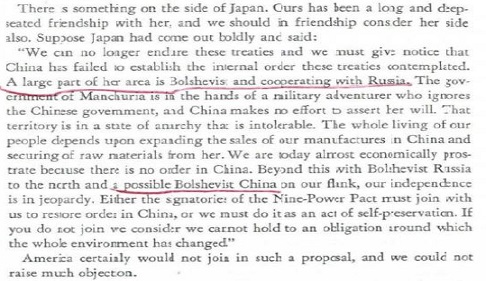 Earlier, President Hoover, who personally nipped the post-WWI communist uprisings in Germany and Hungary with the grains embargo, fed Lenin the ingenuity, i.e., the [worldwide communist revolution] road to Paris lay through Peking.
They of course forgot that
after the eruption of the 1937 Sino-Japanese War, the Americans, biased towards Japan and against China, adopted a policy of "neutrality" (what Utley called by "unpositive neutrality") against the 'belligerent' countries, namely, Japan and China, which was free and unrestrained arms sale to Japan and de facto arms embargo against China.
Note that the Japanese navy had a full blockade of China's coastline.
Note that the blockade would choke China since China did not have an industrial base to produce the basic weapons while Japan's factories could roll out the warships and airplanes on a wholesale scale.
Also note that in contrast with the Americans, the European powers, being constrained by the mediation role of the League of Nations, dared not openly sell arms to Japan.
Through 1940-1941, prior to the U.S. revocation of the 1911 U.S.-Japan Commerce Treaty, the Americans were the biggest supplier of raw material, oil, aviation oil, and weapons, to the extent that some U.S. senator called by Scott making a claim that out of every one million Chinese killed by the Japanese, 544,000 Chinese were killed by the Americans.
Thirty-one U.S. congressional members made a joint declaration to the effect that the U.S., not NAZI Germany, nor Italy, was the best ally of Japan.
Earlier, President Hoover, who personally nipped the post-WWI communist uprisings in Germany and Hungary with the grains embargo, fed Lenin the ingenuity, i.e., the [worldwide communist revolution] road to Paris lay through Peking.
They of course forgot that
after the eruption of the 1937 Sino-Japanese War, the Americans, biased towards Japan and against China, adopted a policy of "neutrality" (what Utley called by "unpositive neutrality") against the 'belligerent' countries, namely, Japan and China, which was free and unrestrained arms sale to Japan and de facto arms embargo against China.
Note that the Japanese navy had a full blockade of China's coastline.
Note that the blockade would choke China since China did not have an industrial base to produce the basic weapons while Japan's factories could roll out the warships and airplanes on a wholesale scale.
Also note that in contrast with the Americans, the European powers, being constrained by the mediation role of the League of Nations, dared not openly sell arms to Japan.
Through 1940-1941, prior to the U.S. revocation of the 1911 U.S.-Japan Commerce Treaty, the Americans were the biggest supplier of raw material, oil, aviation oil, and weapons, to the extent that some U.S. senator called by Scott making a claim that out of every one million Chinese killed by the Japanese, 544,000 Chinese were killed by the Americans.
Thirty-one U.S. congressional members made a joint declaration to the effect that the U.S., not NAZI Germany, nor Italy, was the best ally of Japan.
 Not to mention that the Japanese navy had a full blockade of China's coastline.
America, the 'stars' that engendered or heralded the rise of the [Japan] 'sun', long ago had the blueprint to make Japan into a stalwart against China and Russia, i.e., the source of the Yellow Peril and the source of the Half-Tartars [or the Russians], respectively, --whom the Americans could not assimilate according to George Kennan.
William Christian Bullitt Jr. (1891-1967) disclosed that the Americans' national policy or strategic aim was to see the Russians and Japanese' holding a balance of power against each other in China rather than seeing either the Russians or the Japanese overpowering the other party in taking control of China.
In making this geopolitical decision, you had victimized the 1 billion humble Chinese peasants.
(Note President Wilson's doctrine that the intactness of China was vital to the white civilization -- in the sense that the nation of China should be managed delicately, that is, should not be allowed to grow too powerful to pose threat to the white civilization, nor should it be allowed to be hijacked by a non-U.S. power since China's immense human labor could be turned against the white civilization.
The theme of China to the white civilization, morphing superficially into a ***hypocritical*** American national policy of engagement with Communist China for changing the Chinese communists' behavior, rested on the same underlying logic:
"The
China Exception: Russian Communism being wicked, the
Chinese are good communists", which is an inherent fear
of the Yellow Peril,
i.e., billion Chinese would actually enjoy real
democracy, go to college and develop their intelligence.
Now, President Biden, a stooge of Communist China, explicitly abandoned the
hypocritical American policy of engagement to change communist China to his imbecilic communist buddy and dictator Xi Jinping.
Other than the stooge Bidens who ripped communist China's financial coffer (Tony Bobulinski FULL INTERVIEW Tucker Carlson), don't forget that President Roosevelt boasted of his family's ripping the China trade money in the 19th century, i.e., the opium trade;
and President Hoover certainly got the first bin of gold from the Kai-luan coal mine in collusion with the British during the 1900-1901 boxers' incident-related invasion.)
Not to mention that the Japanese navy had a full blockade of China's coastline.
America, the 'stars' that engendered or heralded the rise of the [Japan] 'sun', long ago had the blueprint to make Japan into a stalwart against China and Russia, i.e., the source of the Yellow Peril and the source of the Half-Tartars [or the Russians], respectively, --whom the Americans could not assimilate according to George Kennan.
William Christian Bullitt Jr. (1891-1967) disclosed that the Americans' national policy or strategic aim was to see the Russians and Japanese' holding a balance of power against each other in China rather than seeing either the Russians or the Japanese overpowering the other party in taking control of China.
In making this geopolitical decision, you had victimized the 1 billion humble Chinese peasants.
(Note President Wilson's doctrine that the intactness of China was vital to the white civilization -- in the sense that the nation of China should be managed delicately, that is, should not be allowed to grow too powerful to pose threat to the white civilization, nor should it be allowed to be hijacked by a non-U.S. power since China's immense human labor could be turned against the white civilization.
The theme of China to the white civilization, morphing superficially into a ***hypocritical*** American national policy of engagement with Communist China for changing the Chinese communists' behavior, rested on the same underlying logic:
"The
China Exception: Russian Communism being wicked, the
Chinese are good communists", which is an inherent fear
of the Yellow Peril,
i.e., billion Chinese would actually enjoy real
democracy, go to college and develop their intelligence.
Now, President Biden, a stooge of Communist China, explicitly abandoned the
hypocritical American policy of engagement to change communist China to his imbecilic communist buddy and dictator Xi Jinping.
Other than the stooge Bidens who ripped communist China's financial coffer (Tony Bobulinski FULL INTERVIEW Tucker Carlson), don't forget that President Roosevelt boasted of his family's ripping the China trade money in the 19th century, i.e., the opium trade;
and President Hoover certainly got the first bin of gold from the Kai-luan coal mine in collusion with the British during the 1900-1901 boxers' incident-related invasion.)
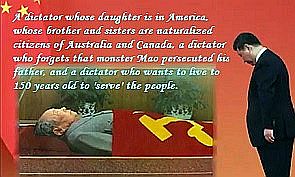 Now, you, as the midwife who delivered China into the communist hands, are morally obligated to take China [and North Korea {and Vietnam}] out of communism.
This time, you may feel your hands forced as North Korea, with its nuclear weapons, could become Communist China's cecal appendix in a repeat of history.
(The Chicoms don't understand the urgency of Trump's trade war having the roots in nuclear North Korea, nor the domino effect on North Korea and Russia after the knock-out of communist China.
Putin thought he would reap profits by sitting on the fence of the U.S.-China trade war, i.e., the Zheltorossiya dream
- revitalized by Aleksandr Gelyevich Dugin
[, and India would not be satisfied with grabbing South Tibet, Bhutan, and Sikkim alone].
Previously, this webmaster thought that the Americans could be hoodwinked by the Chicoms who might just sign any agreement just for sake of getting a red carpet at the White House in lieu of a visit to Mar-a-Lago.
With Trump's war with Communist China flaring up, this webmaster believed that China's dictator would continue to commit blunders and became the tomb digger for the Chinese communist regime.
The thuggery communists, who would not allow the millions of the Hongkong people to have autonomy, could have caused the demise of the regime over the inevitable crackdown, not knowing that the communist ascension to power had its very roots in Churchill's collusion with Roosevelt in selling out the Republic of China for sake of retaining crown jewel Hongkong after hoodwinking Wellington Koo and Chiang Kai-shek that Britain would return Hongkong to China after Japan was to surrender so as not to damage the British wartime morale.
--What happened was that Putin first jumped off the fence ahead of communist China in launching an invasion of Ukraine.)
Now, you, as the midwife who delivered China into the communist hands, are morally obligated to take China [and North Korea {and Vietnam}] out of communism.
This time, you may feel your hands forced as North Korea, with its nuclear weapons, could become Communist China's cecal appendix in a repeat of history.
(The Chicoms don't understand the urgency of Trump's trade war having the roots in nuclear North Korea, nor the domino effect on North Korea and Russia after the knock-out of communist China.
Putin thought he would reap profits by sitting on the fence of the U.S.-China trade war, i.e., the Zheltorossiya dream
- revitalized by Aleksandr Gelyevich Dugin
[, and India would not be satisfied with grabbing South Tibet, Bhutan, and Sikkim alone].
Previously, this webmaster thought that the Americans could be hoodwinked by the Chicoms who might just sign any agreement just for sake of getting a red carpet at the White House in lieu of a visit to Mar-a-Lago.
With Trump's war with Communist China flaring up, this webmaster believed that China's dictator would continue to commit blunders and became the tomb digger for the Chinese communist regime.
The thuggery communists, who would not allow the millions of the Hongkong people to have autonomy, could have caused the demise of the regime over the inevitable crackdown, not knowing that the communist ascension to power had its very roots in Churchill's collusion with Roosevelt in selling out the Republic of China for sake of retaining crown jewel Hongkong after hoodwinking Wellington Koo and Chiang Kai-shek that Britain would return Hongkong to China after Japan was to surrender so as not to damage the British wartime morale.
--What happened was that Putin first jumped off the fence ahead of communist China in launching an invasion of Ukraine.)
|
Should the American politicians follow the footsteps of Anson Burlingame (1820-1870),
Paul Samuel Reinsch (1869-1923)
and
Patrick Jay Hurley (1883-1963), i.e., three most prominent U.S. statemen who loved China and the Chinese people,
then the Chinese people could have a chance of salvation from the communist tyranny.
Note the historic recurrence and the repetition of similar events:
Anson Burlingame, in opposition to the anti-Chinese discriminatory whirlwinds rampant in the U.S. in the 19th century, authored the Burlingame Treaty for China and
died for China in 1870 in St. Petersburg
while still on the Manchu China's mission to the U.S. and Europe;
Paul Samuel Reinsch, who was disillusioned by President Wilson's betrayal of China over the division of WWI spoils at the Paris Peace Conference, quit the minister-to-China job to work for China and died for China in Shanghai in 1923;
and
Patrick Jay Hurley, who convinced President Roosevelt of the American moral blunders in selling out the Republic of China at Tehran and Yalta, personally travelled to Moscow and London for sake of averting and reverting China's fate of becoming a victim of WWII war spoils (i.e., the loss of Port Arthur and Hong Kong, etc.), but failed to make remedy to the secret Tehran and Yalta agreements in the aftermath of President Roosevelt's death in April 1945.
|
|
For better understanding the head-on collision between the United States and Communuist China,
refer to
the U.S.-China fatalistic conjunction through the hands of the Japanese firepower during WWII, that derived from the American unpositive neutrality;
the U.S.-China fatalistic conjunction through the hands of communist army's firepower during the 1945-1950 civil war, that derived from American-supplied Soviet August Storm weapons; and
the U.S.-China fatalistic conjunction through Joseph Stalin, Kim Il Sung and Mao Tse-ting's hands during the 1950-1953 Korean War.
|
|
|
|
More, refer to the Communist Platonic Club at wartime capital Chungking
and
The American Involvement in China: the Soviet Operation Snow, the I.P.R. Conspiracy, the Dixie Mission, the Stilwell Incident, the O.S.S. Scheme, the Coalition Government Crap, the Amerasia Case, & The China White Paper.
|
|
|
|
Taiwan & the Korean War
MacArthur, who echoed the State Department's 'trustee' status theory for Taiwan, at one time invited General Sun Li-jen to visiting Japan and instigated General Sun Li-jen in taking control of Taiwan.
Dean Rusk at one time claimed to have a letter from Sun Li-jen about agitation to take over power from Chiang Kai-shek.
Meanwhile, Chiang Kai-shek had purportedly sent a letter to Truman, expressing his wish to retire and leave power [for sake of obtaining the American support for the Taiwan government].
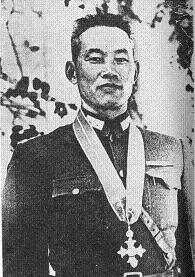 General Sun Li-Jen, who was empowered as the infantry commander-in-chief in Taiwan on March 25, 1950, would lose his utility after the eruption of the Korean War, with his lieutenants being arrested one by one, ending in the deprivation of his job and lifelong house arrest after the signing of the 1954 Taiwan-U.S. Mutual Defence Treaty.
Sun Li-Jen, a graduate of the Virginia Military Institute, was a brilliant general versed in the ancient military tactics and strategies.
In 1942, General Sun Liren (Sun Li-Jen) rescued 7000 British cowards from the Japanese encirclement at Yenangyaung, for which he received King George's medal "Order of the British Empire'.
In April 1946, Sun routed the communist crack armies of the 8th Route Army and the New 4th Corps at the Battle of Siping, driving the communists to the north of the Sungari River.
However, as a non-Whampoa and with background from T.V. Soong's gabelle army, Sun did not enjoy trust from Chiang Kai-shek as Chiang did not even trust his brother-in-law T.V. Soong who was both the founder of the Gabelle Army and the actual founder of China's Central Airforce in Jianqiao, Hangzhou.
T.V. Soong himself also chose to live in the U.S. rather Taiwan after the loss of mainland China.
General Sun Li-Jen, who was empowered as the infantry commander-in-chief in Taiwan on March 25, 1950, would lose his utility after the eruption of the Korean War, with his lieutenants being arrested one by one, ending in the deprivation of his job and lifelong house arrest after the signing of the 1954 Taiwan-U.S. Mutual Defence Treaty.
Sun Li-Jen, a graduate of the Virginia Military Institute, was a brilliant general versed in the ancient military tactics and strategies.
In 1942, General Sun Liren (Sun Li-Jen) rescued 7000 British cowards from the Japanese encirclement at Yenangyaung, for which he received King George's medal "Order of the British Empire'.
In April 1946, Sun routed the communist crack armies of the 8th Route Army and the New 4th Corps at the Battle of Siping, driving the communists to the north of the Sungari River.
However, as a non-Whampoa and with background from T.V. Soong's gabelle army, Sun did not enjoy trust from Chiang Kai-shek as Chiang did not even trust his brother-in-law T.V. Soong who was both the founder of the Gabelle Army and the actual founder of China's Central Airforce in Jianqiao, Hangzhou.
T.V. Soong himself also chose to live in the U.S. rather Taiwan after the loss of mainland China.
President Harry Truman, resentful over the purported support by the Republic of China for his political enemy Thomas Dewey, declared a defense curvature excluding Korea & Taiwan in January 1950.
Chiang Kai-shek, throughout the Korean War, attempted to explain to Truman that the ROC never meddled into the American domestic politics. Indeed, the first recorded incident would be in 1954, not in the 1940s.
With Taiwan abandoned by the Americans, Taiwan, for protecting itself, had taken the approach of broadcasting misinformation and disinformation after Wei Daming broke Whang Shenghe couple's Chita-based Soviet wireless station and continued to use the telegraph set to wire to Chita non-existing military activities of American warplanes and warships prior to the 1950 Korean War.
To know what happened to the priority of the Korean Communists' attacks on South Korea and the Chinese Communists' attack at Taiwan, one would still need to go back to the Comintern [Soviet Russian] conspiracy as well as the Communist takeover of the United States government [i.e., a fact that the U.S. is just ashamed of acknowledging].
Historian Shen Yunlong had a writing on Taiwan's sabotage of a Soviet telegraph set in Taipei months before the Korean War eruption. The Taiwan government, after capturing the two agents, deliberately maintained the wireless connection with Chita of the Soviet Far East, continuously broadcasting disinformation, and faking news about the activities of non-existent American planes and American warships in Taiwan.
Per Shen Yunlong, Stalin, bedazzled by the espionage reports, decided to take out the easy target, i.e., South Korea.
On June 26th, 1950, at about 4:00 am, Kim Il Sung, with the backing from Joseph Stalin and Mao Tse-tung, launched a sudden offensive at South Korea. The North Korean army of 135,000 (alternatively numbered 223,000) soldiers, headed by Choo Yong Gum, crossed the 38th parallel.
The South Korean Army, which was a police-converted force, was defeated.
South Korea had survived purely because of a general who previously served as tactician-in-general of the Chinese Youth Army.
Jin Hongyi (Gim Hong-yil, Choi Se-pyeong, Wang Yishu) was responsible for commanding two South Korean divisions during the defense of Daqiu and Pushan in June and July 1950 and won two weeks' time for MacArthur to send in American G.I. to repel the North Korean army.
Jin Hongyi, a war hero at the 1938 Battle of Wanjialing, was a Korean nationalist who came to China in the late 1910s and was sponsored by the Sino-Korean nationalists' alliance for military training under the Guizhou provincial army that harbored the Korean nationalists since the late 1910s and early 1920s.
Jin Hongyi later served as a South Korean ambassador to the Republic of China, Taiwan, enjoying the title of ambassador emeritus with the summa cum laude honor.
The Chinese communists' armies, which had already concentrated on the Zhejiang-Fujian coastline for avenging communist general Ye Fei's debacle in a prior Battle of the Quemoy Island, had to relocate to Korea.
During the Battle of Quemoy, it was Sun Li-jen's newly-trained regiments that inadvertently blunted the communist army's landing that deviated from a different landing spot due to the sea tide-related drifting that was purportedly a deliberate sabotage by the fishermen drafted by the communists.
Immediately after the eruption of the Korea War, President Truman dispatched the 7th Fleet into the Taiwan Straits and declared the trustee status for Taiwan, nominally for neutralizing the CCP-KMT conflict but ostensibly for assuring the Chinese Communists that China should have no worry about a "Second Battlefield" other than the Korean War.
After being questioned by the news media as to what the U.S. motive was, Truman revised his declaration to state that once the Korean War crisis was over, the American 7th Fleet would be withdrawn from the Taiwan Straits.
Truman, who concurred with Acheson's declaration to exclude South Korea and Taiwan from the Aleutian Arc, had a change of mind on Taiwan but still instructed MacArthur with exerting only the American air and navy force to helping South Korea, which enraged MacArthur so much that he told his followers to do nothing and then flew to Taiwan.
Three times, Truman vetoed the plan to invoke the Republic of China's armed forces for deployment to the Korean peninsula.
The Soviet-hijacked American government did not modify the anti-Chiang Kai-shek policy till after the eruption of the Korean War, with MacArthur sending in a Survey Team to Taiwan in October 1950 and Karl L. Rankin signing an agreement on the American "Military Assistance and Advisory Group" mission in January-February 1951, which led to William Curtis Chase's being sent to Taiwan as a delegation chief in 1951.
It would be after Dwight David Eisenhower became president in the 1953 that the U.S. would declare the secret Yalta treaty to be invalid and began to support Chiang Kai-shek's regime in Taiwan.
Taiwan followed through with voiding the 1945 Sino-Soviet friendship treaty, a treaty that Stalin was initially reluctant to replace with the Mao-proposed 1950 USSR-PRC friendship treaty for the befuddled legality that it was built on top of Churchill and Roosevelt's Yalta endorsements.
 At the same time, the Soviet agents in the U.S. government continued the scheme of nullifying Taiwan's status as part of China, using the excuse and pretext from the relatively loosely-termed Yalta Agreement to make a case of Taiwan as a trustee country, and splitting Chiang Kai-shek's government with the training of a THIRD FORCE military band in Okinawa and elsewhere.
After the eruption of the Korean War, on which occasion Truman declared Taiwan a trustee island against the objection of Acheson, Acheson, who refused to see Wellington Koo for well over one year after issuing The China White Paper, massaged words to explain the U.S. government's standground that the Yalta declaration in regards to Taiwan was only binding to the Four Powers and hence Taiwan's trustee status needed to be put on the United Nations' agenda.
Literatus Lin Yutang published an op-ed with a question: Should the United States put Taiwan under the United Nations' trusteeship, the Republic of China could request that Ryukyu be put under the trustee status of the United nations.
Rusk and Acheson then promised that should the Republic of China refrain from objecting to the Taiwan trusteeship issue, the United States would defeat the Soviet and their satellite states' motion to allow a Communist China observer to enter the U.N. to raise protests in regards to American bombing of the Sino-Korean border area and the 7th Fleet's violation of communist China's sovereighty in entering the Taiwan Straits.
Chiang Kai-shek's son, suspicious of the Americans' design of THE THIRD FORCE, banished or rejected the staff who worked with the American THIRD FORCE, such as Mao Sen who had to go into exile in Hongkong and the United States, successively.
See the C.I.A. farce of training a group of the former Chinese Nationalist Army troops as a Third Force, and in 1952, parachuting John T. Downey and Richard G. Fecteau into Manchuria, which led to the two guys falling into victims as the communist prisoners of war till the early 1970s.
Mao Sen, a brilliant guerrilla general who undertook the dangerous underground work in Shanghai after the Japanese busting of the Military Statistics Service network in October-November 1941 and the subsequent loss of protection from the French Concession and International Settlement ensuing from the 1941 Pearl Harbor attack, had worked with Milton Miles and the O.S.S. team throughout the years of 1944 and 1945, for which Mao Sen received numerous medals from the Americans for the intelligence gathering that contributed to the Americans' defeating the Japanese army and navy in the Pacific War.
At the same time, the Soviet agents in the U.S. government continued the scheme of nullifying Taiwan's status as part of China, using the excuse and pretext from the relatively loosely-termed Yalta Agreement to make a case of Taiwan as a trustee country, and splitting Chiang Kai-shek's government with the training of a THIRD FORCE military band in Okinawa and elsewhere.
After the eruption of the Korean War, on which occasion Truman declared Taiwan a trustee island against the objection of Acheson, Acheson, who refused to see Wellington Koo for well over one year after issuing The China White Paper, massaged words to explain the U.S. government's standground that the Yalta declaration in regards to Taiwan was only binding to the Four Powers and hence Taiwan's trustee status needed to be put on the United Nations' agenda.
Literatus Lin Yutang published an op-ed with a question: Should the United States put Taiwan under the United Nations' trusteeship, the Republic of China could request that Ryukyu be put under the trustee status of the United nations.
Rusk and Acheson then promised that should the Republic of China refrain from objecting to the Taiwan trusteeship issue, the United States would defeat the Soviet and their satellite states' motion to allow a Communist China observer to enter the U.N. to raise protests in regards to American bombing of the Sino-Korean border area and the 7th Fleet's violation of communist China's sovereighty in entering the Taiwan Straits.
Chiang Kai-shek's son, suspicious of the Americans' design of THE THIRD FORCE, banished or rejected the staff who worked with the American THIRD FORCE, such as Mao Sen who had to go into exile in Hongkong and the United States, successively.
See the C.I.A. farce of training a group of the former Chinese Nationalist Army troops as a Third Force, and in 1952, parachuting John T. Downey and Richard G. Fecteau into Manchuria, which led to the two guys falling into victims as the communist prisoners of war till the early 1970s.
Mao Sen, a brilliant guerrilla general who undertook the dangerous underground work in Shanghai after the Japanese busting of the Military Statistics Service network in October-November 1941 and the subsequent loss of protection from the French Concession and International Settlement ensuing from the 1941 Pearl Harbor attack, had worked with Milton Miles and the O.S.S. team throughout the years of 1944 and 1945, for which Mao Sen received numerous medals from the Americans for the intelligence gathering that contributed to the Americans' defeating the Japanese army and navy in the Pacific War.
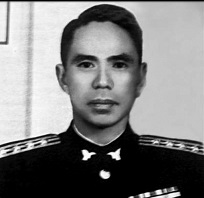 Mao Sen did not know during WWII that his work for Milton Miles and the American Navy was hijacked by the CPUSA-controlled O.S.S., i.e., predecessor to the C.I.A.
(American Milton Miles, who was persecuted by the Soviet-hijacked O.S.S., never ever disclosed to Mao Sen or Dai Li that the Chinese party was actually working for the O.S.S., not the American Navy. Miles could not get out of the quagmire set up by the Soviet agents and died of depression.)
Mao Sen did not know during WWII that his work for Milton Miles and the American Navy was hijacked by the CPUSA-controlled O.S.S., i.e., predecessor to the C.I.A.
(American Milton Miles, who was persecuted by the Soviet-hijacked O.S.S., never ever disclosed to Mao Sen or Dai Li that the Chinese party was actually working for the O.S.S., not the American Navy. Miles could not get out of the quagmire set up by the Soviet agents and died of depression.)
General Sun Li-Jen, who was empowered as the infantry commander-in-chief in Taiwan on March 25, 1950, would lose his utility after the eruption of the Korean War, with his lieutenants being arrested one by one, ending in the deprivation of his job and lifelong house arrest after the signing of the 1954 Taiwan-U.S. Mutual Defence Treaty [which was a dilemma treaty that Chiang Kai-shek decided to enter into, after the Chinese communists, who signed the 1953 Korean Armistice Agreement, in commotion launched a massive bombardment of the Quemoy Island on September 3rd, 1954, a dilemma in the sense that the Americans had told Chiang Kai-shek that the alliance with the U.S., defensive in nature, prohibited Taiwan from proactively attacking the mainland to drag the Americans into a war and would render it invalid if otherwise.
Note that the Quemoy and Matsu islands were not covered by the 1954 Taiwan-U.S. Mutual Defence Treaty. Only the Penghu Islands (Pescadores) and Taiwan were under the protection of the treaty.
* In Commemoration of China's Fall under the Alien Conquests in A.D. 1279,
A.D. 1644 & A.D. 1949 *
 U.S.S.R./Comintern Alliance with the KMT & CCP (1923-1927)
U.S.S.R./Comintern Alliance with the KMT & CCP (1923-1927)
 Korean/Chinese Communists & the 1931 Japanese Invasion of Manchuria Korean/Chinese Communists & the 1931 Japanese Invasion of Manchuria
American Involvement in China: Soviet Operation Snow, IPR Conspiracy, Dixie Mission, Stilwell
Incident, O.S.S. Scheme, Coalition Government Crap, Amerasia Case & The China White Paper
* Stay tuned for "Republican China 1911-1955: A Complete Untold History" *
|
|
Zou Rong's Revolutionary Army;
Shin Kyu Sik's
Shrine (Spirit, Kunitama) of Korea
|
This snippet is for sons and daughters of China:
Heed the sons & ministers' agony and sorrow of our ancestors who died or lived through the Mongol, Manchu and Soviet-Chicom conquest
and
the Yongjia, Jingkang and Jiashen cataclysms !
Jeanne d'Arc of China:
Teenager girl Xun Guan breaking out of the Wancheng city to borrow the relief troops in the late Western Jinn dynasty;
Liu-Shao-shi riding into the barbarian army to rescue her husband in the late Western Jinn dynasty;
teenager girl Shen Yunying breaking into Zhang Xianzhong's rebels on the horseback to avenge on father's death in the late Ming dynasty.
China's Solitary and Lone Heroes:
Nan Jiyun breaking out of the Suiyang siege and charging back into the city in the Tang dynasty;
Zhang Gui & Zhang Shun Brothers breaking through the Mongol siege of Xiangyang in the Southern Soong dynasty;
Liu Tiejun breaking through three communist field armies' siege of Kaifeng in the Republican China time period;
Zhang Jian's lone confrontation against the communist army during the June 3rd & 4th Massacre of 1989.
|
|
|
|
TEN TRAINS EQUIVALENT AMERICAN LEND-LEASE WEAPONS THAT STALIN & RUSSIANS GAVE TO MAO & CHINESE COMMUNISTS;
FORTY SHIPS EQUIVALENT QUANTITY OF TANKS & CANNONS, BOTH AMERICAN-MADE & JAPAN-MADE
3300 TONS OF PETROL FROM RUSSIANS IN 1947 ALONE; PLUS 2000 TONS OF DIESEL, 1000 TONS OF PLANE FUEL, 700 TONS OF EXPLOSIVES & 2000 TONS OF MACHINERY OIL
30000 TONS OF PETROL FROM RUSSIANS IN 1948; PLUS 1000 TONS OF PLANE FUEL, 5000 TONS OF KEROSINE, 3000 HEAVY WEIGHT TRUCKS & 150 ARTILLERY TRACTORS
DEATH OF MILLIONS OF YELLOW MEN, & POSSIBLY MORE IN THE FUTURE WAR AGAINST TAIWAN !!!!!
Reference: see the writing by James Perloff China Betrayed Into Communism on Friday, 24 July 2009 at
http://www.thenewamerican.com/index.php/history/world/1464
August Storm lend-lease weapons ended up in Mao's hands.
"At the Teheran and Yalta wartime conferences, however, Roosevelt asked Stalin if he would break his pact with Japan and enter the Far East war. Stalin agreed, but attached conditions. He demanded that America completely equip his Far Eastern Army for the expedition, with 3,000 tanks, 5,000 planes, plus all the other munitions, food, and fuel required for a 1,250,000-man army. Roosevelt accepted this demand, and 600 shiploads of Lend-Lease material were convoyed to the USSR for the venture. Stalin's Far Eastern Army swiftly received more than twice [should be ten times] the supplies we gave Chiang Kai-shek during four years as our ally.
"General Douglas MacArthur protested after discovering that ships designated to supply his Pacific forces were being diverted to Russia. Major General Courtney Whitney wrote: 'One hundred of his transport ships were to be withdrawn immediately, to be used to carry munitions and supplies across the North Pacific to the Soviet forces in Vladivostok.... Later, of course, they were the basis of Soviet military support of North Korea and Red China.'
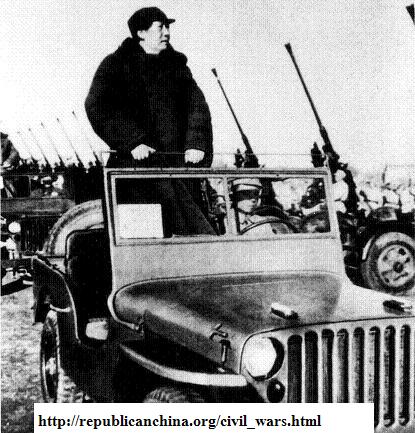
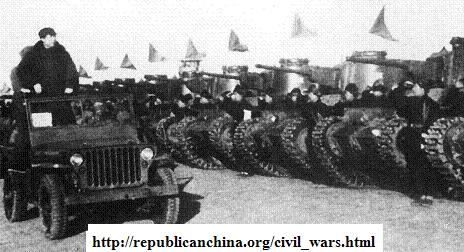
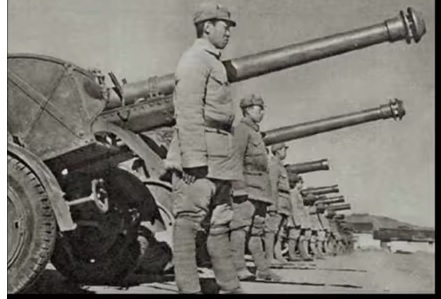 The pseudo-encyclopedia website like wikipedia also made the fallacious claim that would make the Chinese communists laugh to the teeth:
"However, the nearly nonexistent Soviet help proved not to be a problem for the Communists; in the meantime, the huge Communist need was filled by an unexpected source: their adversaries, the Nationalists. Due to the fatal mistake the Nationalists made in their demilitarization, the Communists were able to pinpoint nearly every Japanese secret depot with the help of former Nationalist troops in their ranks, and the total amount of Japanese weaponry recovered was enough to sustain the Communists for 2 years before relying on captured American weaponry from the Nationalists in the later stage of the war. For example, a single secret depot typically contained as much as 150,000 artillery rounds. By February 1947, hundreds of artillery pieces were recovered by the communists, including: 49 howitzers, 300 heavy mortars, 137 anti-aircraft artilleries, 141 anti-tank guns, 108 mountain guns, 97 cannons, and many other smaller artillery pieces, almost one-third of the Nationalist weaponry."
The pseudo-encyclopedia website like wikipedia also made the fallacious claim that would make the Chinese communists laugh to the teeth:
"However, the nearly nonexistent Soviet help proved not to be a problem for the Communists; in the meantime, the huge Communist need was filled by an unexpected source: their adversaries, the Nationalists. Due to the fatal mistake the Nationalists made in their demilitarization, the Communists were able to pinpoint nearly every Japanese secret depot with the help of former Nationalist troops in their ranks, and the total amount of Japanese weaponry recovered was enough to sustain the Communists for 2 years before relying on captured American weaponry from the Nationalists in the later stage of the war. For example, a single secret depot typically contained as much as 150,000 artillery rounds. By February 1947, hundreds of artillery pieces were recovered by the communists, including: 49 howitzers, 300 heavy mortars, 137 anti-aircraft artilleries, 141 anti-tank guns, 108 mountain guns, 97 cannons, and many other smaller artillery pieces, almost one-third of the Nationalist weaponry."
|
|
|
The communists had conquered China owning to the key battle success in Manchuria, which was the result of treacheries on the part of Wei Lihuang, i.e., the government troops' commander-in-chief in Manchuria, a treachery that was comparable to Soong Dynasty prime minister Jia Sidao's abandoning to the Mongol the Xiangyang city [which was under siege for 4-5 years] and Ming Dynasty general Wu Sangui's betrayal of the Mountain and Sea Pass to the Manchus.
Wei Lihuang, with the communist mole by his side from the days of the resistance war, overrode General Wang Tiehan's proposal and made the government army into the sitting ducks in the isolated pockets and cities of Manchuria, for the communist army to attack.
Namely, Wei Lihuang allowed the communist army to take the transcendental secret manoeuvre to ship thousands of artillery to the foot of the Jinzhou city wall under the assistance of the Soviet railway army corps.
General Wang Tiehan suggested that the Changchun garrison troops could break out towards Mukden to the south as intelligence had shown that the communist army had disappeared along the trunk line of Changchun-Jirin-Mukden.
Only the 52nd Corps, that was hoodwinked by Wei Lihuang into attacking towards Shenyang [i.e., Mukden] as the relief troops but impeded by the communist army halfway for lack of coordination between Wei Lihuang and the communist army, managed to return to wrestle back the Yingkou port to escape the Manchurian battleground via sea.
A part of the Youth Army division, which broke out of the Mukden siege, fought its way along the Liao-xi Corridor to arrive at the Mountain and Sea Pass.
We don't need to remind the readers that the communist army was a motley group of mercenaries including about 250,000 ethnic-Korean Japanese Kwantung Army diehards per Kim Il-sun plus the Japanese 8th Route Army (i.e., the Japanese medical staff, airforce staff, officer corps, and tank and artillery operators), the ethnic-Taiwan Japanese Kwantung Army, the Outer Mongolian cavalry army, not counting the Soviet railway army corps.
According to the Soviets, the 'railway' tag was a guise for intervening in the Chinese civil wars, namely, the cloak of secrecy under which the Soviets orchestrated the historical Soviet conquest of China to fulfill Stalin's mantle that pro-Soviet regimes must be established in all territories that the Soviet Red Army ever stepped on, no matter Europe or Asia.
That is, Soviet military staff, not merely Soviet military advisers, fought the Chinese civil wars in Manchuria as the railway staff.
Ivan V. Kovalev, as Stalin and All-Union Communist Party (Bolsheviks)'s plenipotentiary to the Chinese Communist Party (CCP), was sent to China for directing the civil war as a railway czar.

George Kennan's Fallacious Disclaim of Soviet Instigation and Bankrupt 'Long' Containment View:
George Kennan
naively discounted
the Chinese communist revolution as "part of the Soviet system" and asserted its victory to be an
exception to the Soviet "military intimidation or invasion" and not a result that could be ascribed
"primarily to Soviet propaganda or instigation" (American Diplomacy, p. 119. The U of Chi Press 1951,
expanded edition).
George Kennan's bankrupt 'long' view as to communism was "a long-term, patient but firm and vigilant containment", which was to seek solutions in the "historical"
context, namely,
the "Russian or the oriental mind" of the "Russian-Asiatic world", something the communist China twin shared, that was
seemingly perceived as an innate matter that could not be overcome.

|
|
|
|
|
Wu [no] Wang [forgetting] Zai [at] Ju [the Ju fort]
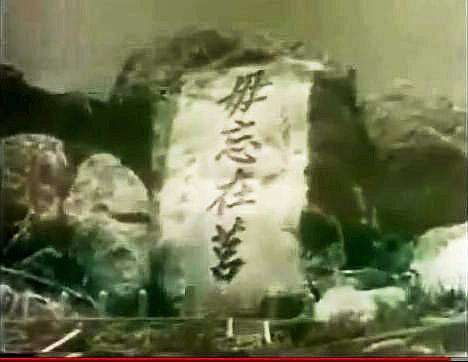
|
TO BE CONTINUED !!!!!
written by Ah Xiang
|
|

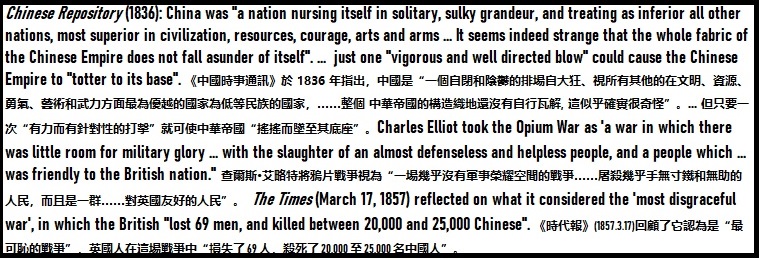
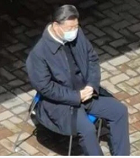








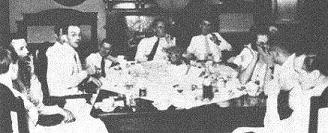
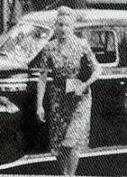
![Though, Anna Wang [Anneliese Martens], in her memoirs, expressed jealousy over Gong Peng by stating that the Anglo-American reporters had flattered the Chinese communists and the communist movement as a result of being entranced with the goldfish-eye'ed personal assistant of Zhou Enlai](GongPeng.jpg)
















 General Sun Li-Jen, who was empowered as the infantry commander-in-chief in Taiwan on March 25, 1950, would lose his utility after the eruption of the Korean War, with his lieutenants being arrested one by one, ending in the deprivation of his job and lifelong house arrest after the signing of the 1954 Taiwan-U.S. Mutual Defence Treaty.
Sun Li-Jen, a graduate of the Virginia Military Institute, was a brilliant general versed in the ancient military tactics and strategies.
In 1942, General Sun Liren (Sun Li-Jen) rescued 7000 British cowards from the Japanese encirclement at Yenangyaung, for which he received King George's medal "Order of the British Empire'.
In April 1946, Sun routed the communist crack armies of the 8th Route Army and the New 4th Corps at the Battle of Siping, driving the communists to the north of the Sungari River.
However, as a non-Whampoa and with background from T.V. Soong's gabelle army, Sun did not enjoy trust from Chiang Kai-shek as Chiang did not even trust his brother-in-law T.V. Soong who was both the founder of the Gabelle Army and the actual founder of China's Central Airforce in Jianqiao, Hangzhou.
T.V. Soong himself also chose to live in the U.S. rather Taiwan after the loss of mainland China.
General Sun Li-Jen, who was empowered as the infantry commander-in-chief in Taiwan on March 25, 1950, would lose his utility after the eruption of the Korean War, with his lieutenants being arrested one by one, ending in the deprivation of his job and lifelong house arrest after the signing of the 1954 Taiwan-U.S. Mutual Defence Treaty.
Sun Li-Jen, a graduate of the Virginia Military Institute, was a brilliant general versed in the ancient military tactics and strategies.
In 1942, General Sun Liren (Sun Li-Jen) rescued 7000 British cowards from the Japanese encirclement at Yenangyaung, for which he received King George's medal "Order of the British Empire'.
In April 1946, Sun routed the communist crack armies of the 8th Route Army and the New 4th Corps at the Battle of Siping, driving the communists to the north of the Sungari River.
However, as a non-Whampoa and with background from T.V. Soong's gabelle army, Sun did not enjoy trust from Chiang Kai-shek as Chiang did not even trust his brother-in-law T.V. Soong who was both the founder of the Gabelle Army and the actual founder of China's Central Airforce in Jianqiao, Hangzhou.
T.V. Soong himself also chose to live in the U.S. rather Taiwan after the loss of mainland China.

 Mao Sen did not know during WWII that his work for Milton Miles and the American Navy was hijacked by the CPUSA-controlled O.S.S., i.e., predecessor to the C.I.A.
(American Milton Miles, who was persecuted by the Soviet-hijacked O.S.S., never ever disclosed to Mao Sen or Dai Li that the Chinese party was actually working for the O.S.S., not the American Navy. Miles could not get out of the quagmire set up by the Soviet agents and died of depression.)
Mao Sen did not know during WWII that his work for Milton Miles and the American Navy was hijacked by the CPUSA-controlled O.S.S., i.e., predecessor to the C.I.A.
(American Milton Miles, who was persecuted by the Soviet-hijacked O.S.S., never ever disclosed to Mao Sen or Dai Li that the Chinese party was actually working for the O.S.S., not the American Navy. Miles could not get out of the quagmire set up by the Soviet agents and died of depression.)

